Understanding Management & Operations in Business
VerifiedAdded on 2021/02/09
|26
|7736
|34
AI Summary
Contribute Materials
Your contribution can guide someone’s learning journey. Share your
documents today.
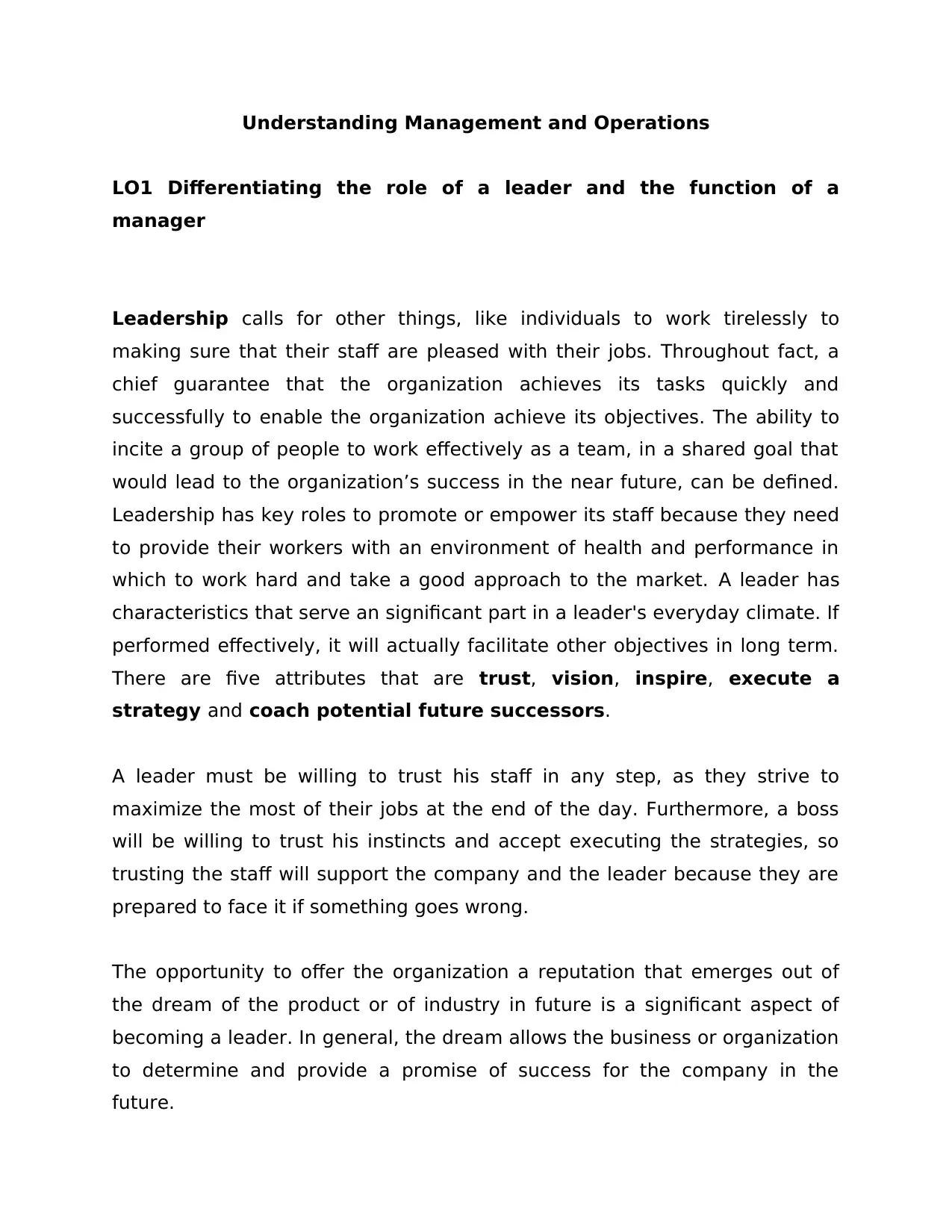
Understanding Management and Operations
LO1 Differentiating the role of a leader and the function of a
manager
Leadership calls for other things, like individuals to work tirelessly to
making sure that their staff are pleased with their jobs. Throughout fact, a
chief guarantee that the organization achieves its tasks quickly and
successfully to enable the organization achieve its objectives. The ability to
incite a group of people to work effectively as a team, in a shared goal that
would lead to the organization’s success in the near future, can be defined.
Leadership has key roles to promote or empower its staff because they need
to provide their workers with an environment of health and performance in
which to work hard and take a good approach to the market. A leader has
characteristics that serve an significant part in a leader's everyday climate. If
performed effectively, it will actually facilitate other objectives in long term.
There are five attributes that are trust, vision, inspire, execute a
strategy and coach potential future successors.
A leader must be willing to trust his staff in any step, as they strive to
maximize the most of their jobs at the end of the day. Furthermore, a boss
will be willing to trust his instincts and accept executing the strategies, so
trusting the staff will support the company and the leader because they are
prepared to face it if something goes wrong.
The opportunity to offer the organization a reputation that emerges out of
the dream of the product or of industry in future is a significant aspect of
becoming a leader. In general, the dream allows the business or organization
to determine and provide a promise of success for the company in the
future.
LO1 Differentiating the role of a leader and the function of a
manager
Leadership calls for other things, like individuals to work tirelessly to
making sure that their staff are pleased with their jobs. Throughout fact, a
chief guarantee that the organization achieves its tasks quickly and
successfully to enable the organization achieve its objectives. The ability to
incite a group of people to work effectively as a team, in a shared goal that
would lead to the organization’s success in the near future, can be defined.
Leadership has key roles to promote or empower its staff because they need
to provide their workers with an environment of health and performance in
which to work hard and take a good approach to the market. A leader has
characteristics that serve an significant part in a leader's everyday climate. If
performed effectively, it will actually facilitate other objectives in long term.
There are five attributes that are trust, vision, inspire, execute a
strategy and coach potential future successors.
A leader must be willing to trust his staff in any step, as they strive to
maximize the most of their jobs at the end of the day. Furthermore, a boss
will be willing to trust his instincts and accept executing the strategies, so
trusting the staff will support the company and the leader because they are
prepared to face it if something goes wrong.
The opportunity to offer the organization a reputation that emerges out of
the dream of the product or of industry in future is a significant aspect of
becoming a leader. In general, the dream allows the business or organization
to determine and provide a promise of success for the company in the
future.
Secure Best Marks with AI Grader
Need help grading? Try our AI Grader for instant feedback on your assignments.
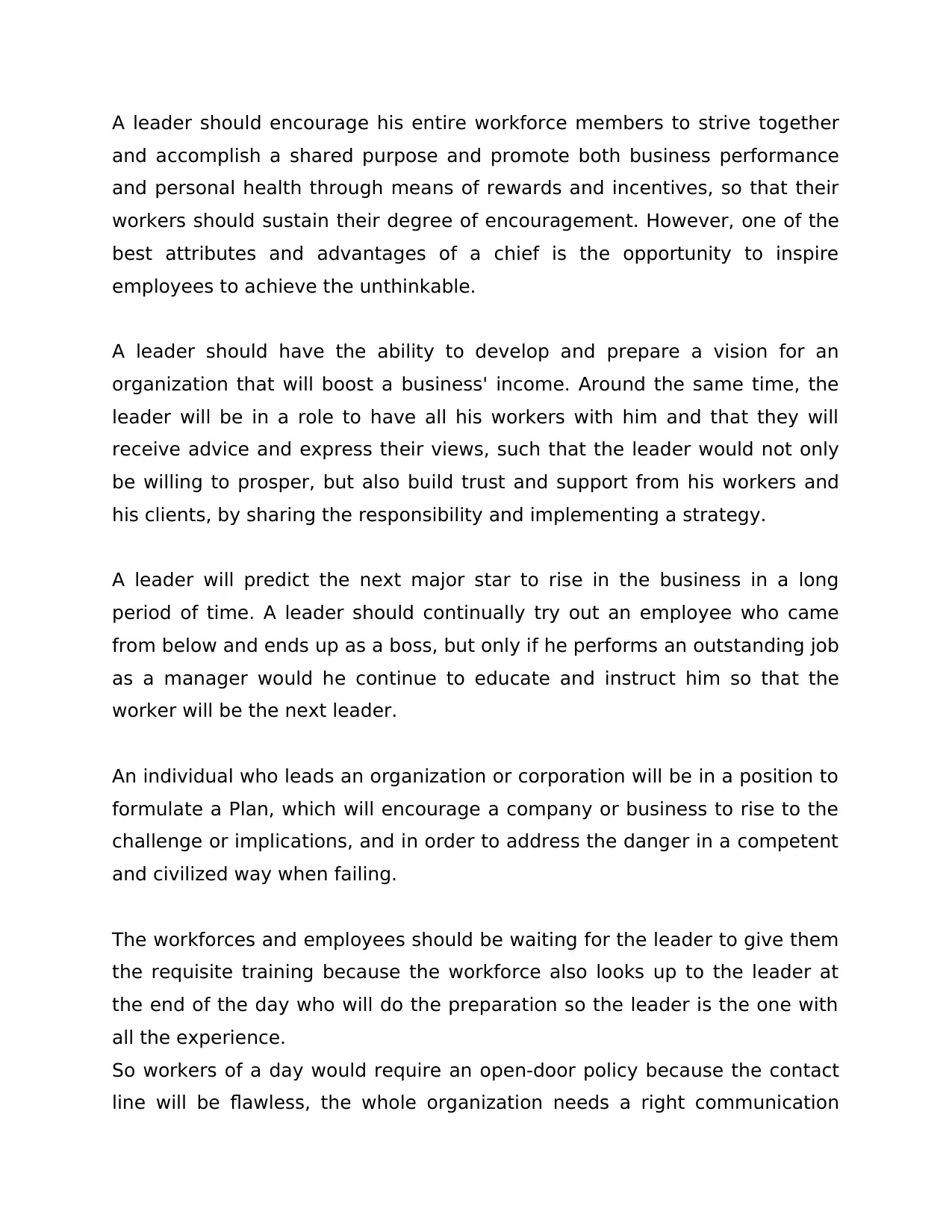
A leader should encourage his entire workforce members to strive together
and accomplish a shared purpose and promote both business performance
and personal health through means of rewards and incentives, so that their
workers should sustain their degree of encouragement. However, one of the
best attributes and advantages of a chief is the opportunity to inspire
employees to achieve the unthinkable.
A leader should have the ability to develop and prepare a vision for an
organization that will boost a business' income. Around the same time, the
leader will be in a role to have all his workers with him and that they will
receive advice and express their views, such that the leader would not only
be willing to prosper, but also build trust and support from his workers and
his clients, by sharing the responsibility and implementing a strategy.
A leader will predict the next major star to rise in the business in a long
period of time. A leader should continually try out an employee who came
from below and ends up as a boss, but only if he performs an outstanding job
as a manager would he continue to educate and instruct him so that the
worker will be the next leader.
An individual who leads an organization or corporation will be in a position to
formulate a Plan, which will encourage a company or business to rise to the
challenge or implications, and in order to address the danger in a competent
and civilized way when failing.
The workforces and employees should be waiting for the leader to give them
the requisite training because the workforce also looks up to the leader at
the end of the day who will do the preparation so the leader is the one with
all the experience.
So workers of a day would require an open-door policy because the contact
line will be flawless, the whole organization needs a right communication
and accomplish a shared purpose and promote both business performance
and personal health through means of rewards and incentives, so that their
workers should sustain their degree of encouragement. However, one of the
best attributes and advantages of a chief is the opportunity to inspire
employees to achieve the unthinkable.
A leader should have the ability to develop and prepare a vision for an
organization that will boost a business' income. Around the same time, the
leader will be in a role to have all his workers with him and that they will
receive advice and express their views, such that the leader would not only
be willing to prosper, but also build trust and support from his workers and
his clients, by sharing the responsibility and implementing a strategy.
A leader will predict the next major star to rise in the business in a long
period of time. A leader should continually try out an employee who came
from below and ends up as a boss, but only if he performs an outstanding job
as a manager would he continue to educate and instruct him so that the
worker will be the next leader.
An individual who leads an organization or corporation will be in a position to
formulate a Plan, which will encourage a company or business to rise to the
challenge or implications, and in order to address the danger in a competent
and civilized way when failing.
The workforces and employees should be waiting for the leader to give them
the requisite training because the workforce also looks up to the leader at
the end of the day who will do the preparation so the leader is the one with
all the experience.
So workers of a day would require an open-door policy because the contact
line will be flawless, the whole organization needs a right communication
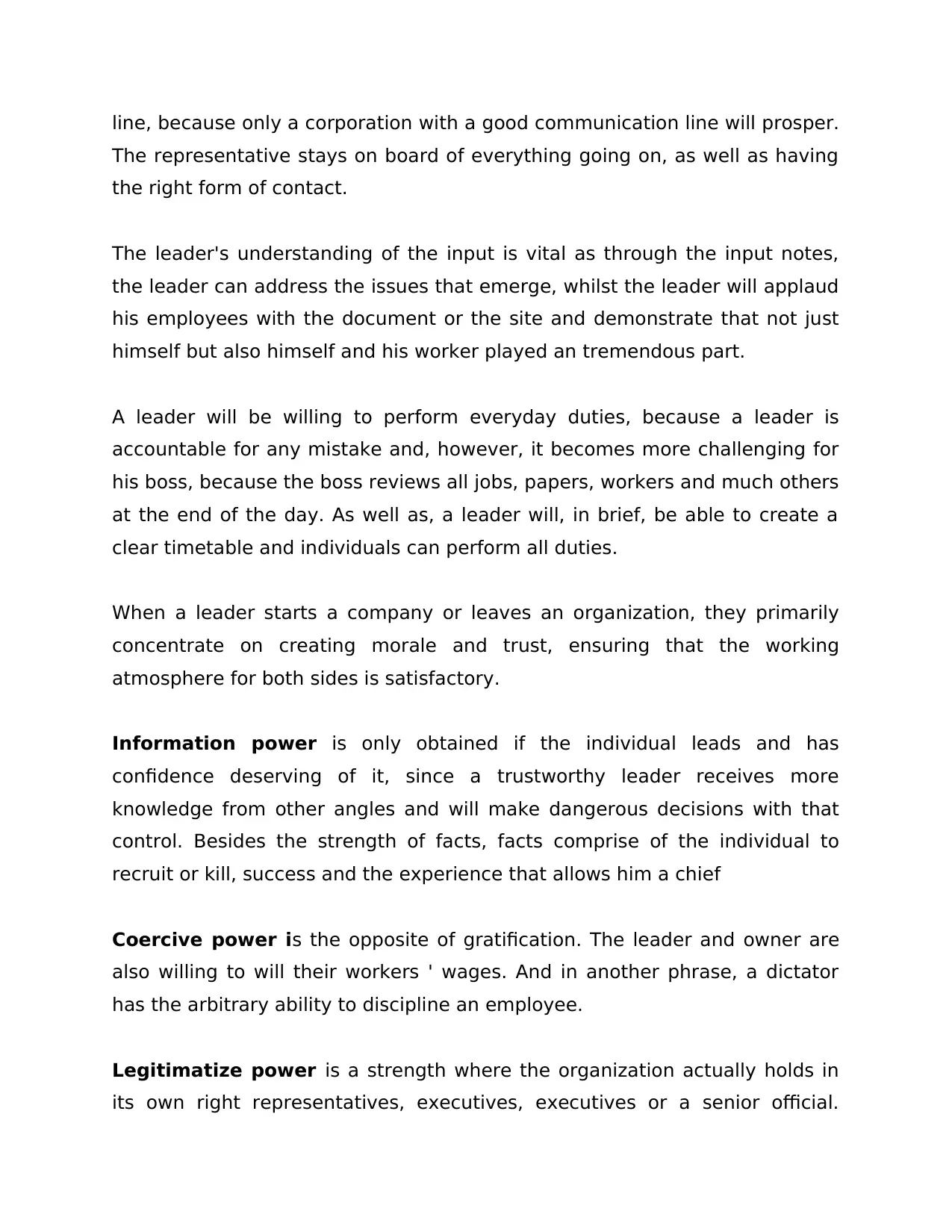
line, because only a corporation with a good communication line will prosper.
The representative stays on board of everything going on, as well as having
the right form of contact.
The leader's understanding of the input is vital as through the input notes,
the leader can address the issues that emerge, whilst the leader will applaud
his employees with the document or the site and demonstrate that not just
himself but also himself and his worker played an tremendous part.
A leader will be willing to perform everyday duties, because a leader is
accountable for any mistake and, however, it becomes more challenging for
his boss, because the boss reviews all jobs, papers, workers and much others
at the end of the day. As well as, a leader will, in brief, be able to create a
clear timetable and individuals can perform all duties.
When a leader starts a company or leaves an organization, they primarily
concentrate on creating morale and trust, ensuring that the working
atmosphere for both sides is satisfactory.
Information power is only obtained if the individual leads and has
confidence deserving of it, since a trustworthy leader receives more
knowledge from other angles and will make dangerous decisions with that
control. Besides the strength of facts, facts comprise of the individual to
recruit or kill, success and the experience that allows him a chief
Coercive power is the opposite of gratification. The leader and owner are
also willing to will their workers ' wages. And in another phrase, a dictator
has the arbitrary ability to discipline an employee.
Legitimatize power is a strength where the organization actually holds in
its own right representatives, executives, executives or a senior official.
The representative stays on board of everything going on, as well as having
the right form of contact.
The leader's understanding of the input is vital as through the input notes,
the leader can address the issues that emerge, whilst the leader will applaud
his employees with the document or the site and demonstrate that not just
himself but also himself and his worker played an tremendous part.
A leader will be willing to perform everyday duties, because a leader is
accountable for any mistake and, however, it becomes more challenging for
his boss, because the boss reviews all jobs, papers, workers and much others
at the end of the day. As well as, a leader will, in brief, be able to create a
clear timetable and individuals can perform all duties.
When a leader starts a company or leaves an organization, they primarily
concentrate on creating morale and trust, ensuring that the working
atmosphere for both sides is satisfactory.
Information power is only obtained if the individual leads and has
confidence deserving of it, since a trustworthy leader receives more
knowledge from other angles and will make dangerous decisions with that
control. Besides the strength of facts, facts comprise of the individual to
recruit or kill, success and the experience that allows him a chief
Coercive power is the opposite of gratification. The leader and owner are
also willing to will their workers ' wages. And in another phrase, a dictator
has the arbitrary ability to discipline an employee.
Legitimatize power is a strength where the organization actually holds in
its own right representatives, executives, executives or a senior official.
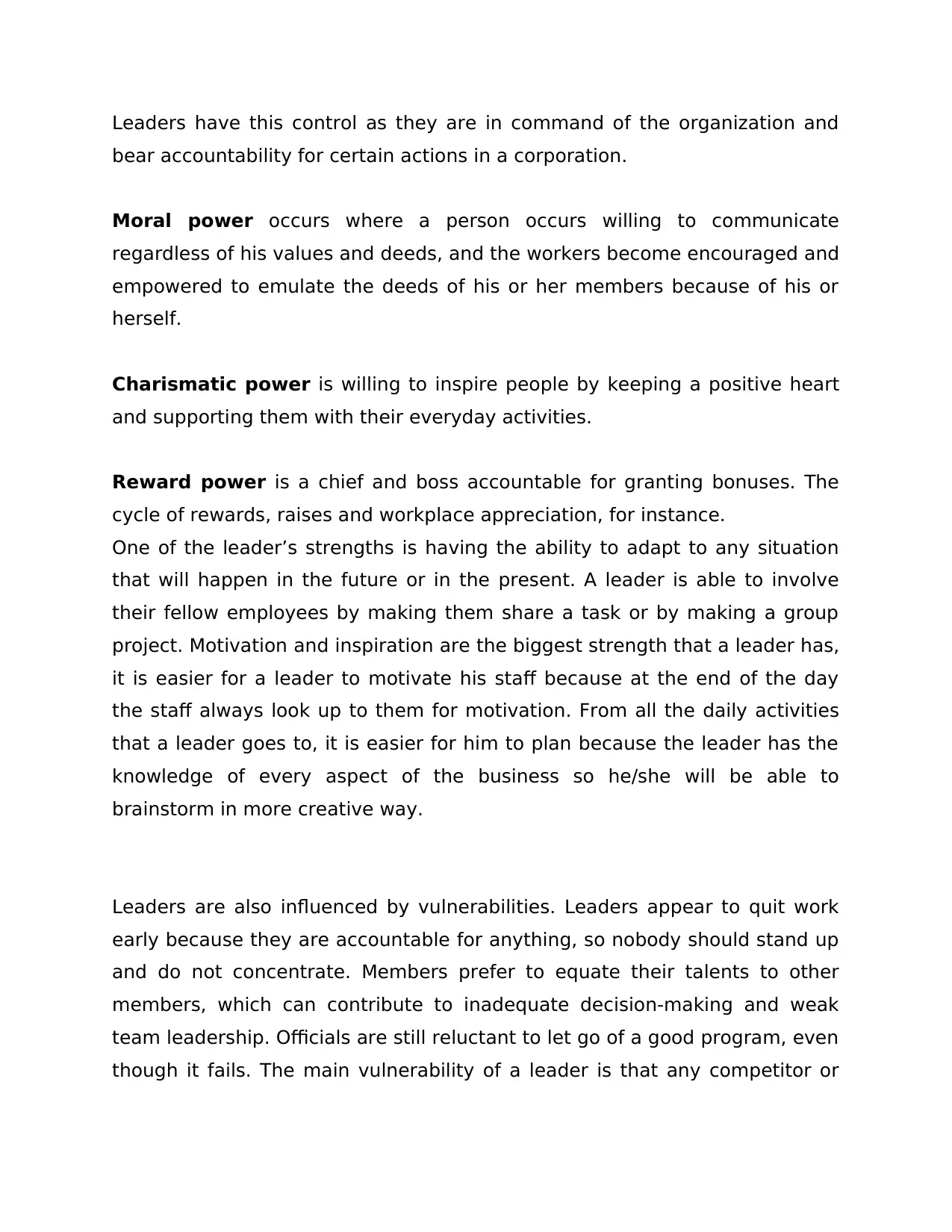
Leaders have this control as they are in command of the organization and
bear accountability for certain actions in a corporation.
Moral power occurs where a person occurs willing to communicate
regardless of his values and deeds, and the workers become encouraged and
empowered to emulate the deeds of his or her members because of his or
herself.
Charismatic power is willing to inspire people by keeping a positive heart
and supporting them with their everyday activities.
Reward power is a chief and boss accountable for granting bonuses. The
cycle of rewards, raises and workplace appreciation, for instance.
One of the leader’s strengths is having the ability to adapt to any situation
that will happen in the future or in the present. A leader is able to involve
their fellow employees by making them share a task or by making a group
project. Motivation and inspiration are the biggest strength that a leader has,
it is easier for a leader to motivate his staff because at the end of the day
the staff always look up to them for motivation. From all the daily activities
that a leader goes to, it is easier for him to plan because the leader has the
knowledge of every aspect of the business so he/she will be able to
brainstorm in more creative way.
Leaders are also influenced by vulnerabilities. Leaders appear to quit work
early because they are accountable for anything, so nobody should stand up
and do not concentrate. Members prefer to equate their talents to other
members, which can contribute to inadequate decision-making and weak
team leadership. Officials are still reluctant to let go of a good program, even
though it fails. The main vulnerability of a leader is that any competitor or
bear accountability for certain actions in a corporation.
Moral power occurs where a person occurs willing to communicate
regardless of his values and deeds, and the workers become encouraged and
empowered to emulate the deeds of his or her members because of his or
herself.
Charismatic power is willing to inspire people by keeping a positive heart
and supporting them with their everyday activities.
Reward power is a chief and boss accountable for granting bonuses. The
cycle of rewards, raises and workplace appreciation, for instance.
One of the leader’s strengths is having the ability to adapt to any situation
that will happen in the future or in the present. A leader is able to involve
their fellow employees by making them share a task or by making a group
project. Motivation and inspiration are the biggest strength that a leader has,
it is easier for a leader to motivate his staff because at the end of the day
the staff always look up to them for motivation. From all the daily activities
that a leader goes to, it is easier for him to plan because the leader has the
knowledge of every aspect of the business so he/she will be able to
brainstorm in more creative way.
Leaders are also influenced by vulnerabilities. Leaders appear to quit work
early because they are accountable for anything, so nobody should stand up
and do not concentrate. Members prefer to equate their talents to other
members, which can contribute to inadequate decision-making and weak
team leadership. Officials are still reluctant to let go of a good program, even
though it fails. The main vulnerability of a leader is that any competitor or
Secure Best Marks with AI Grader
Need help grading? Try our AI Grader for instant feedback on your assignments.
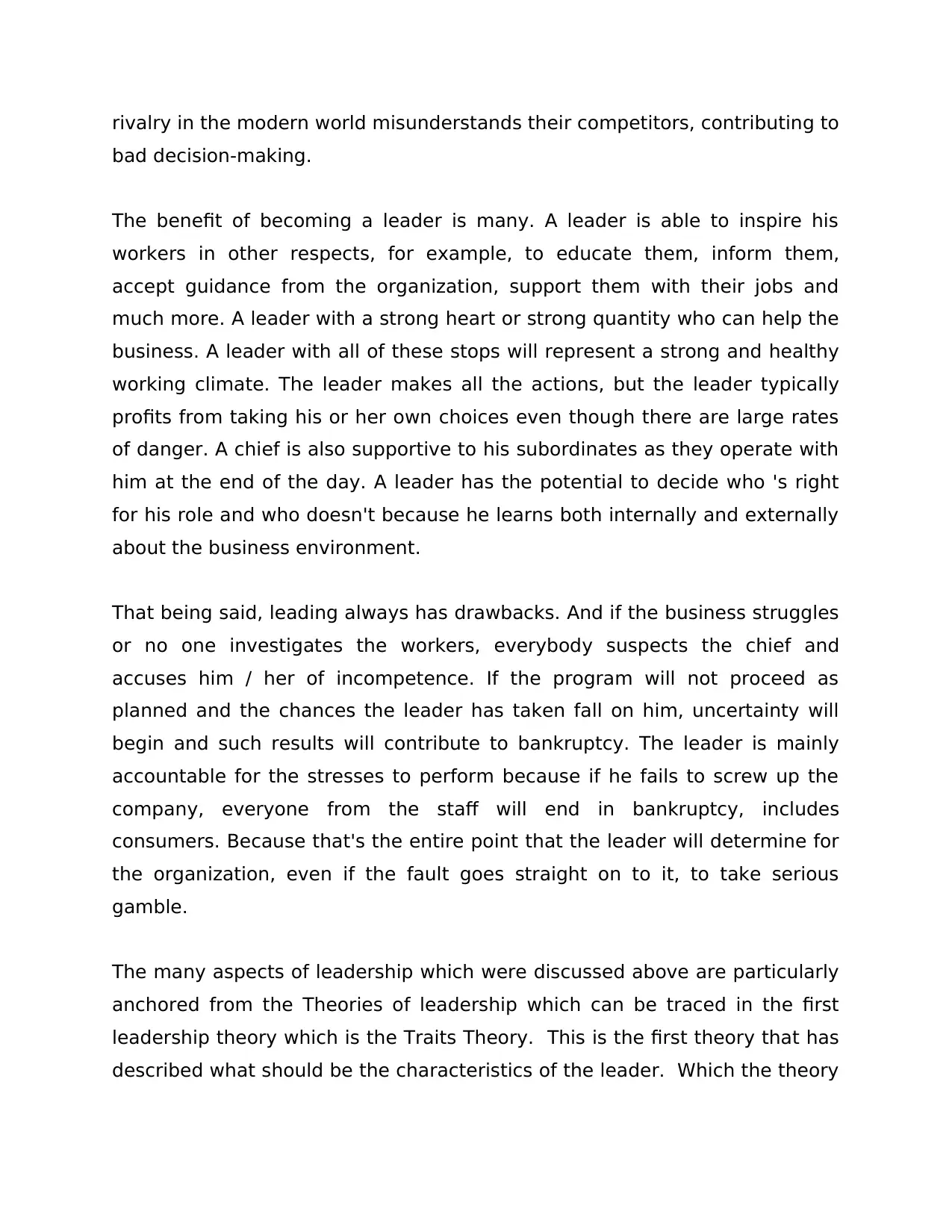
rivalry in the modern world misunderstands their competitors, contributing to
bad decision-making.
The benefit of becoming a leader is many. A leader is able to inspire his
workers in other respects, for example, to educate them, inform them,
accept guidance from the organization, support them with their jobs and
much more. A leader with a strong heart or strong quantity who can help the
business. A leader with all of these stops will represent a strong and healthy
working climate. The leader makes all the actions, but the leader typically
profits from taking his or her own choices even though there are large rates
of danger. A chief is also supportive to his subordinates as they operate with
him at the end of the day. A leader has the potential to decide who 's right
for his role and who doesn't because he learns both internally and externally
about the business environment.
That being said, leading always has drawbacks. And if the business struggles
or no one investigates the workers, everybody suspects the chief and
accuses him / her of incompetence. If the program will not proceed as
planned and the chances the leader has taken fall on him, uncertainty will
begin and such results will contribute to bankruptcy. The leader is mainly
accountable for the stresses to perform because if he fails to screw up the
company, everyone from the staff will end in bankruptcy, includes
consumers. Because that's the entire point that the leader will determine for
the organization, even if the fault goes straight on to it, to take serious
gamble.
The many aspects of leadership which were discussed above are particularly
anchored from the Theories of leadership which can be traced in the first
leadership theory which is the Traits Theory. This is the first theory that has
described what should be the characteristics of the leader. Which the theory
bad decision-making.
The benefit of becoming a leader is many. A leader is able to inspire his
workers in other respects, for example, to educate them, inform them,
accept guidance from the organization, support them with their jobs and
much more. A leader with a strong heart or strong quantity who can help the
business. A leader with all of these stops will represent a strong and healthy
working climate. The leader makes all the actions, but the leader typically
profits from taking his or her own choices even though there are large rates
of danger. A chief is also supportive to his subordinates as they operate with
him at the end of the day. A leader has the potential to decide who 's right
for his role and who doesn't because he learns both internally and externally
about the business environment.
That being said, leading always has drawbacks. And if the business struggles
or no one investigates the workers, everybody suspects the chief and
accuses him / her of incompetence. If the program will not proceed as
planned and the chances the leader has taken fall on him, uncertainty will
begin and such results will contribute to bankruptcy. The leader is mainly
accountable for the stresses to perform because if he fails to screw up the
company, everyone from the staff will end in bankruptcy, includes
consumers. Because that's the entire point that the leader will determine for
the organization, even if the fault goes straight on to it, to take serious
gamble.
The many aspects of leadership which were discussed above are particularly
anchored from the Theories of leadership which can be traced in the first
leadership theory which is the Traits Theory. This is the first theory that has
described what should be the characteristics of the leader. Which the theory
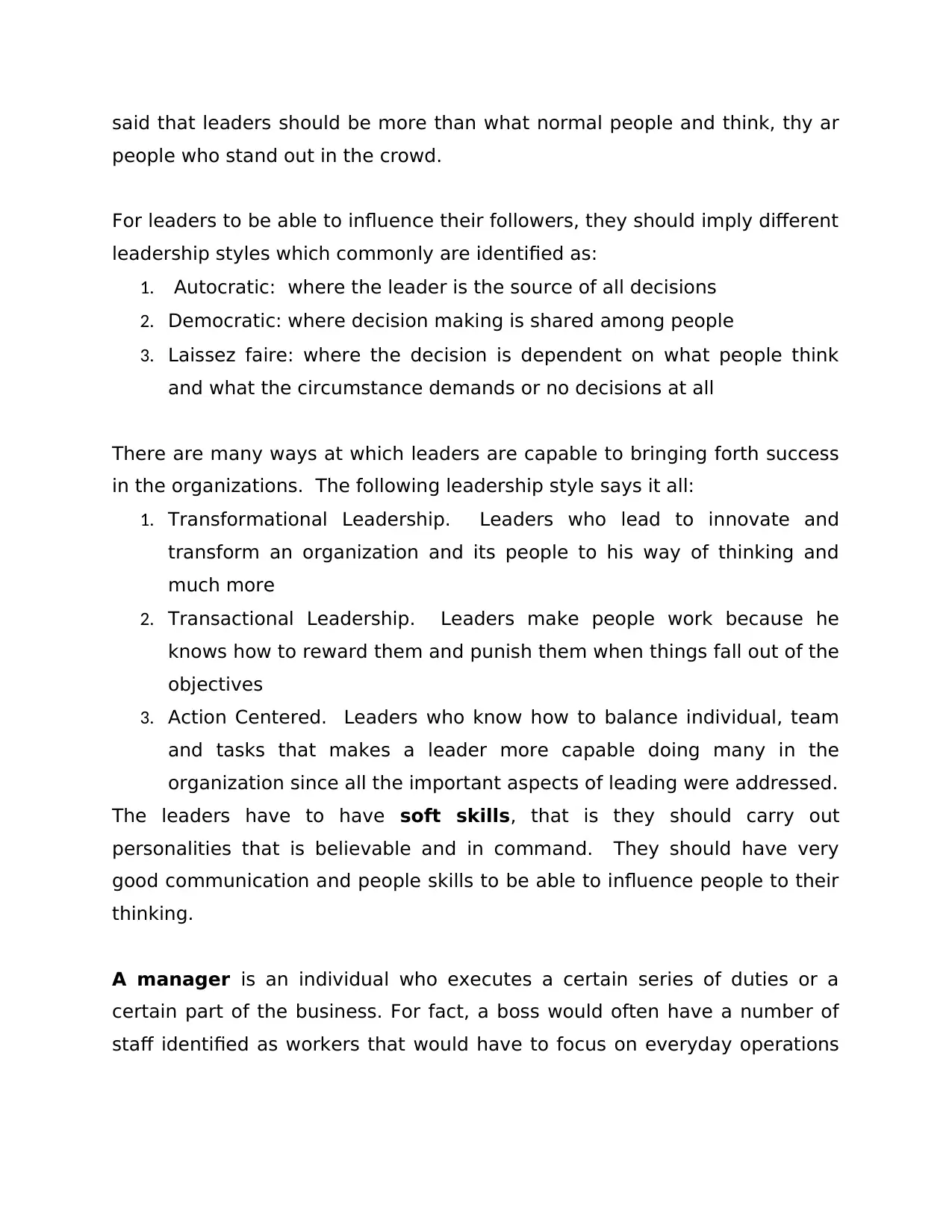
said that leaders should be more than what normal people and think, thy ar
people who stand out in the crowd.
For leaders to be able to influence their followers, they should imply different
leadership styles which commonly are identified as:
1. Autocratic: where the leader is the source of all decisions
2. Democratic: where decision making is shared among people
3. Laissez faire: where the decision is dependent on what people think
and what the circumstance demands or no decisions at all
There are many ways at which leaders are capable to bringing forth success
in the organizations. The following leadership style says it all:
1. Transformational Leadership. Leaders who lead to innovate and
transform an organization and its people to his way of thinking and
much more
2. Transactional Leadership. Leaders make people work because he
knows how to reward them and punish them when things fall out of the
objectives
3. Action Centered. Leaders who know how to balance individual, team
and tasks that makes a leader more capable doing many in the
organization since all the important aspects of leading were addressed.
The leaders have to have soft skills, that is they should carry out
personalities that is believable and in command. They should have very
good communication and people skills to be able to influence people to their
thinking.
A manager is an individual who executes a certain series of duties or a
certain part of the business. For fact, a boss would often have a number of
staff identified as workers that would have to focus on everyday operations
people who stand out in the crowd.
For leaders to be able to influence their followers, they should imply different
leadership styles which commonly are identified as:
1. Autocratic: where the leader is the source of all decisions
2. Democratic: where decision making is shared among people
3. Laissez faire: where the decision is dependent on what people think
and what the circumstance demands or no decisions at all
There are many ways at which leaders are capable to bringing forth success
in the organizations. The following leadership style says it all:
1. Transformational Leadership. Leaders who lead to innovate and
transform an organization and its people to his way of thinking and
much more
2. Transactional Leadership. Leaders make people work because he
knows how to reward them and punish them when things fall out of the
objectives
3. Action Centered. Leaders who know how to balance individual, team
and tasks that makes a leader more capable doing many in the
organization since all the important aspects of leading were addressed.
The leaders have to have soft skills, that is they should carry out
personalities that is believable and in command. They should have very
good communication and people skills to be able to influence people to their
thinking.
A manager is an individual who executes a certain series of duties or a
certain part of the business. For fact, a boss would often have a number of
staff identified as workers that would have to focus on everyday operations
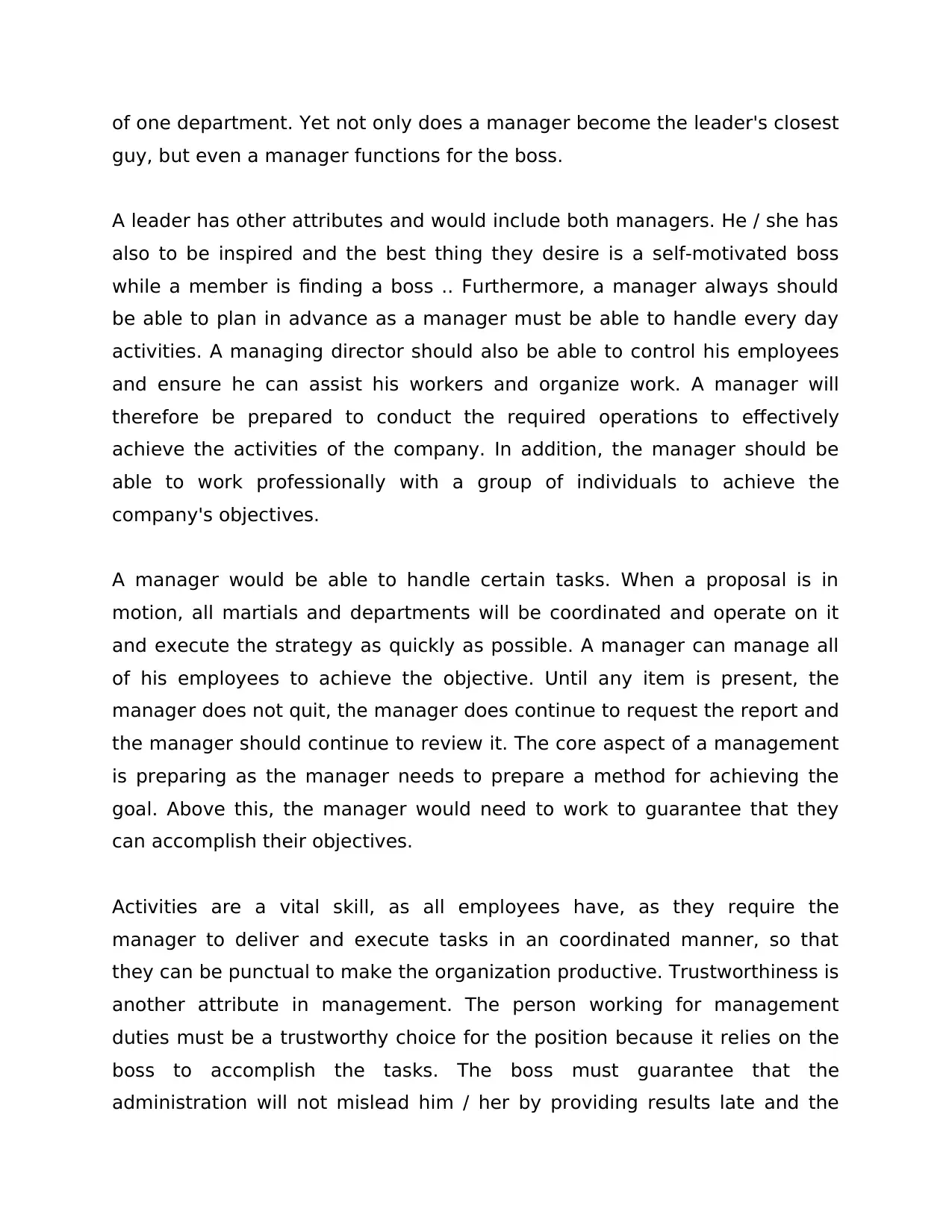
of one department. Yet not only does a manager become the leader's closest
guy, but even a manager functions for the boss.
A leader has other attributes and would include both managers. He / she has
also to be inspired and the best thing they desire is a self-motivated boss
while a member is finding a boss .. Furthermore, a manager always should
be able to plan in advance as a manager must be able to handle every day
activities. A managing director should also be able to control his employees
and ensure he can assist his workers and organize work. A manager will
therefore be prepared to conduct the required operations to effectively
achieve the activities of the company. In addition, the manager should be
able to work professionally with a group of individuals to achieve the
company's objectives.
A manager would be able to handle certain tasks. When a proposal is in
motion, all martials and departments will be coordinated and operate on it
and execute the strategy as quickly as possible. A manager can manage all
of his employees to achieve the objective. Until any item is present, the
manager does not quit, the manager does continue to request the report and
the manager should continue to review it. The core aspect of a management
is preparing as the manager needs to prepare a method for achieving the
goal. Above this, the manager would need to work to guarantee that they
can accomplish their objectives.
Activities are a vital skill, as all employees have, as they require the
manager to deliver and execute tasks in an coordinated manner, so that
they can be punctual to make the organization productive. Trustworthiness is
another attribute in management. The person working for management
duties must be a trustworthy choice for the position because it relies on the
boss to accomplish the tasks. The boss must guarantee that the
administration will not mislead him / her by providing results late and the
guy, but even a manager functions for the boss.
A leader has other attributes and would include both managers. He / she has
also to be inspired and the best thing they desire is a self-motivated boss
while a member is finding a boss .. Furthermore, a manager always should
be able to plan in advance as a manager must be able to handle every day
activities. A managing director should also be able to control his employees
and ensure he can assist his workers and organize work. A manager will
therefore be prepared to conduct the required operations to effectively
achieve the activities of the company. In addition, the manager should be
able to work professionally with a group of individuals to achieve the
company's objectives.
A manager would be able to handle certain tasks. When a proposal is in
motion, all martials and departments will be coordinated and operate on it
and execute the strategy as quickly as possible. A manager can manage all
of his employees to achieve the objective. Until any item is present, the
manager does not quit, the manager does continue to request the report and
the manager should continue to review it. The core aspect of a management
is preparing as the manager needs to prepare a method for achieving the
goal. Above this, the manager would need to work to guarantee that they
can accomplish their objectives.
Activities are a vital skill, as all employees have, as they require the
manager to deliver and execute tasks in an coordinated manner, so that
they can be punctual to make the organization productive. Trustworthiness is
another attribute in management. The person working for management
duties must be a trustworthy choice for the position because it relies on the
boss to accomplish the tasks. The boss must guarantee that the
administration will not mislead him / her by providing results late and the
Paraphrase This Document
Need a fresh take? Get an instant paraphrase of this document with our AI Paraphraser
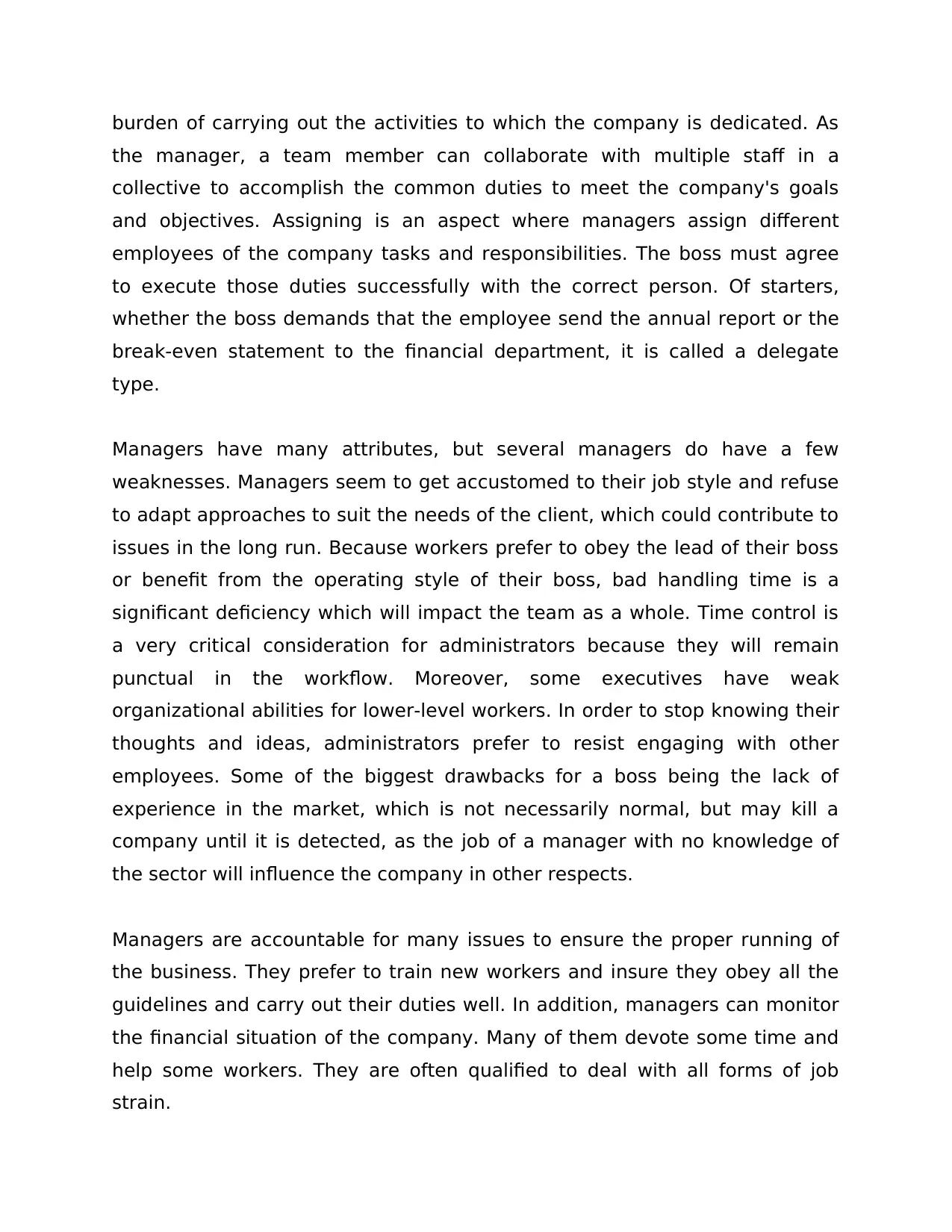
burden of carrying out the activities to which the company is dedicated. As
the manager, a team member can collaborate with multiple staff in a
collective to accomplish the common duties to meet the company's goals
and objectives. Assigning is an aspect where managers assign different
employees of the company tasks and responsibilities. The boss must agree
to execute those duties successfully with the correct person. Of starters,
whether the boss demands that the employee send the annual report or the
break-even statement to the financial department, it is called a delegate
type.
Managers have many attributes, but several managers do have a few
weaknesses. Managers seem to get accustomed to their job style and refuse
to adapt approaches to suit the needs of the client, which could contribute to
issues in the long run. Because workers prefer to obey the lead of their boss
or benefit from the operating style of their boss, bad handling time is a
significant deficiency which will impact the team as a whole. Time control is
a very critical consideration for administrators because they will remain
punctual in the workflow. Moreover, some executives have weak
organizational abilities for lower-level workers. In order to stop knowing their
thoughts and ideas, administrators prefer to resist engaging with other
employees. Some of the biggest drawbacks for a boss being the lack of
experience in the market, which is not necessarily normal, but may kill a
company until it is detected, as the job of a manager with no knowledge of
the sector will influence the company in other respects.
Managers are accountable for many issues to ensure the proper running of
the business. They prefer to train new workers and insure they obey all the
guidelines and carry out their duties well. In addition, managers can monitor
the financial situation of the company. Many of them devote some time and
help some workers. They are often qualified to deal with all forms of job
strain.
the manager, a team member can collaborate with multiple staff in a
collective to accomplish the common duties to meet the company's goals
and objectives. Assigning is an aspect where managers assign different
employees of the company tasks and responsibilities. The boss must agree
to execute those duties successfully with the correct person. Of starters,
whether the boss demands that the employee send the annual report or the
break-even statement to the financial department, it is called a delegate
type.
Managers have many attributes, but several managers do have a few
weaknesses. Managers seem to get accustomed to their job style and refuse
to adapt approaches to suit the needs of the client, which could contribute to
issues in the long run. Because workers prefer to obey the lead of their boss
or benefit from the operating style of their boss, bad handling time is a
significant deficiency which will impact the team as a whole. Time control is
a very critical consideration for administrators because they will remain
punctual in the workflow. Moreover, some executives have weak
organizational abilities for lower-level workers. In order to stop knowing their
thoughts and ideas, administrators prefer to resist engaging with other
employees. Some of the biggest drawbacks for a boss being the lack of
experience in the market, which is not necessarily normal, but may kill a
company until it is detected, as the job of a manager with no knowledge of
the sector will influence the company in other respects.
Managers are accountable for many issues to ensure the proper running of
the business. They prefer to train new workers and insure they obey all the
guidelines and carry out their duties well. In addition, managers can monitor
the financial situation of the company. Many of them devote some time and
help some workers. They are often qualified to deal with all forms of job
strain.
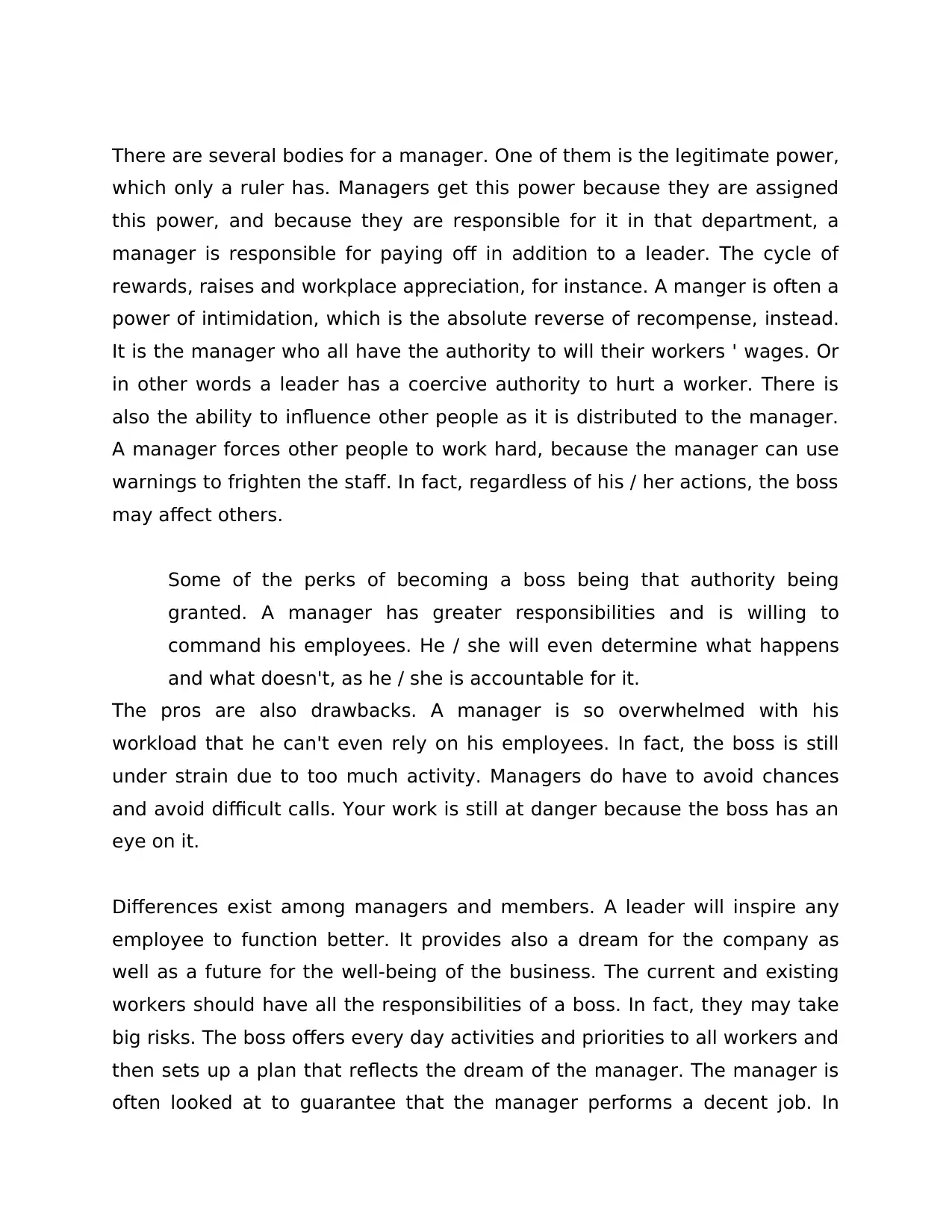
There are several bodies for a manager. One of them is the legitimate power,
which only a ruler has. Managers get this power because they are assigned
this power, and because they are responsible for it in that department, a
manager is responsible for paying off in addition to a leader. The cycle of
rewards, raises and workplace appreciation, for instance. A manger is often a
power of intimidation, which is the absolute reverse of recompense, instead.
It is the manager who all have the authority to will their workers ' wages. Or
in other words a leader has a coercive authority to hurt a worker. There is
also the ability to influence other people as it is distributed to the manager.
A manager forces other people to work hard, because the manager can use
warnings to frighten the staff. In fact, regardless of his / her actions, the boss
may affect others.
Some of the perks of becoming a boss being that authority being
granted. A manager has greater responsibilities and is willing to
command his employees. He / she will even determine what happens
and what doesn't, as he / she is accountable for it.
The pros are also drawbacks. A manager is so overwhelmed with his
workload that he can't even rely on his employees. In fact, the boss is still
under strain due to too much activity. Managers do have to avoid chances
and avoid difficult calls. Your work is still at danger because the boss has an
eye on it.
Differences exist among managers and members. A leader will inspire any
employee to function better. It provides also a dream for the company as
well as a future for the well-being of the business. The current and existing
workers should have all the responsibilities of a boss. In fact, they may take
big risks. The boss offers every day activities and priorities to all workers and
then sets up a plan that reflects the dream of the manager. The manager is
often looked at to guarantee that the manager performs a decent job. In
which only a ruler has. Managers get this power because they are assigned
this power, and because they are responsible for it in that department, a
manager is responsible for paying off in addition to a leader. The cycle of
rewards, raises and workplace appreciation, for instance. A manger is often a
power of intimidation, which is the absolute reverse of recompense, instead.
It is the manager who all have the authority to will their workers ' wages. Or
in other words a leader has a coercive authority to hurt a worker. There is
also the ability to influence other people as it is distributed to the manager.
A manager forces other people to work hard, because the manager can use
warnings to frighten the staff. In fact, regardless of his / her actions, the boss
may affect others.
Some of the perks of becoming a boss being that authority being
granted. A manager has greater responsibilities and is willing to
command his employees. He / she will even determine what happens
and what doesn't, as he / she is accountable for it.
The pros are also drawbacks. A manager is so overwhelmed with his
workload that he can't even rely on his employees. In fact, the boss is still
under strain due to too much activity. Managers do have to avoid chances
and avoid difficult calls. Your work is still at danger because the boss has an
eye on it.
Differences exist among managers and members. A leader will inspire any
employee to function better. It provides also a dream for the company as
well as a future for the well-being of the business. The current and existing
workers should have all the responsibilities of a boss. In fact, they may take
big risks. The boss offers every day activities and priorities to all workers and
then sets up a plan that reflects the dream of the manager. The manager is
often looked at to guarantee that the manager performs a decent job. In
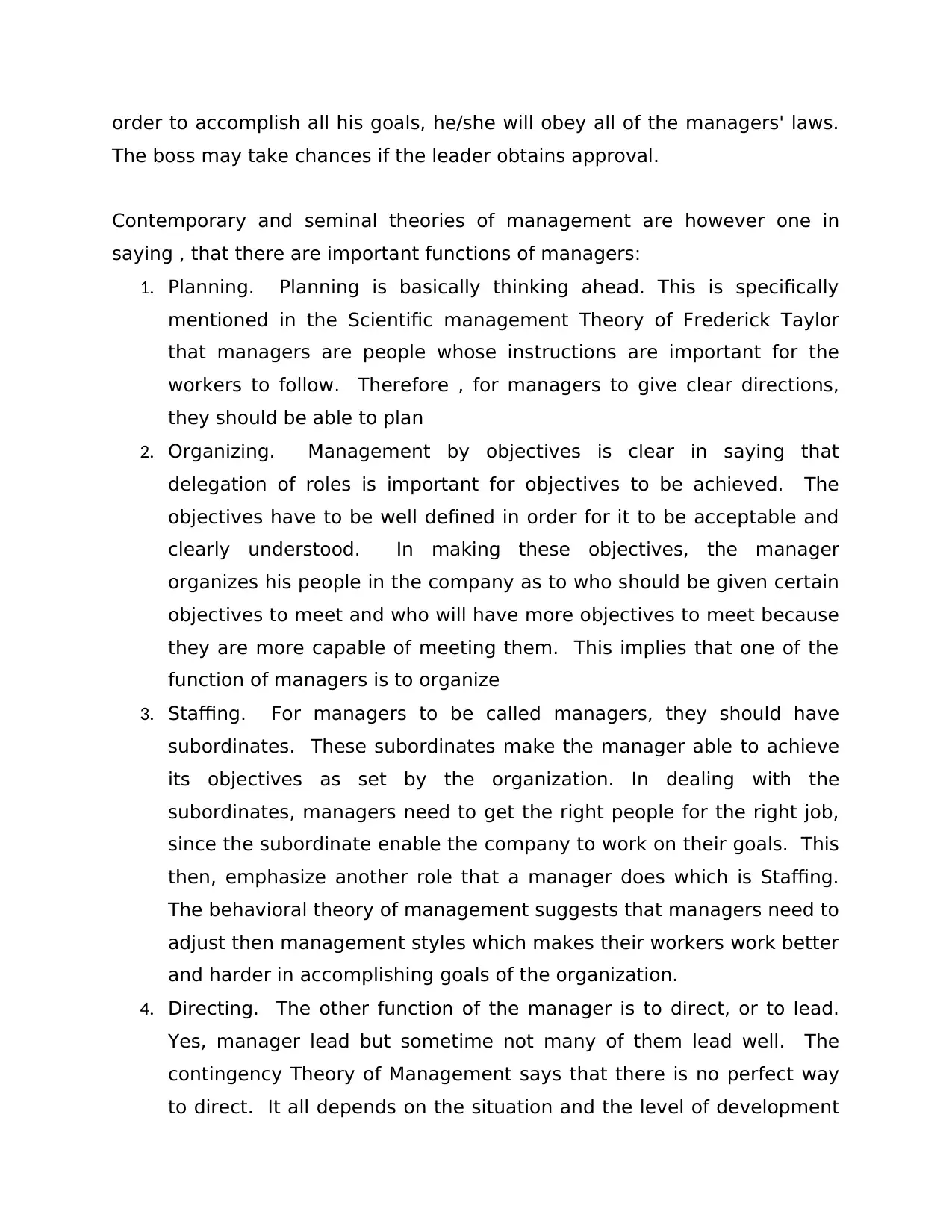
order to accomplish all his goals, he/she will obey all of the managers' laws.
The boss may take chances if the leader obtains approval.
Contemporary and seminal theories of management are however one in
saying , that there are important functions of managers:
1. Planning. Planning is basically thinking ahead. This is specifically
mentioned in the Scientific management Theory of Frederick Taylor
that managers are people whose instructions are important for the
workers to follow. Therefore , for managers to give clear directions,
they should be able to plan
2. Organizing. Management by objectives is clear in saying that
delegation of roles is important for objectives to be achieved. The
objectives have to be well defined in order for it to be acceptable and
clearly understood. In making these objectives, the manager
organizes his people in the company as to who should be given certain
objectives to meet and who will have more objectives to meet because
they are more capable of meeting them. This implies that one of the
function of managers is to organize
3. Staffing. For managers to be called managers, they should have
subordinates. These subordinates make the manager able to achieve
its objectives as set by the organization. In dealing with the
subordinates, managers need to get the right people for the right job,
since the subordinate enable the company to work on their goals. This
then, emphasize another role that a manager does which is Staffing.
The behavioral theory of management suggests that managers need to
adjust then management styles which makes their workers work better
and harder in accomplishing goals of the organization.
4. Directing. The other function of the manager is to direct, or to lead.
Yes, manager lead but sometime not many of them lead well. The
contingency Theory of Management says that there is no perfect way
to direct. It all depends on the situation and the level of development
The boss may take chances if the leader obtains approval.
Contemporary and seminal theories of management are however one in
saying , that there are important functions of managers:
1. Planning. Planning is basically thinking ahead. This is specifically
mentioned in the Scientific management Theory of Frederick Taylor
that managers are people whose instructions are important for the
workers to follow. Therefore , for managers to give clear directions,
they should be able to plan
2. Organizing. Management by objectives is clear in saying that
delegation of roles is important for objectives to be achieved. The
objectives have to be well defined in order for it to be acceptable and
clearly understood. In making these objectives, the manager
organizes his people in the company as to who should be given certain
objectives to meet and who will have more objectives to meet because
they are more capable of meeting them. This implies that one of the
function of managers is to organize
3. Staffing. For managers to be called managers, they should have
subordinates. These subordinates make the manager able to achieve
its objectives as set by the organization. In dealing with the
subordinates, managers need to get the right people for the right job,
since the subordinate enable the company to work on their goals. This
then, emphasize another role that a manager does which is Staffing.
The behavioral theory of management suggests that managers need to
adjust then management styles which makes their workers work better
and harder in accomplishing goals of the organization.
4. Directing. The other function of the manager is to direct, or to lead.
Yes, manager lead but sometime not many of them lead well. The
contingency Theory of Management says that there is no perfect way
to direct. It all depends on the situation and the level of development
Secure Best Marks with AI Grader
Need help grading? Try our AI Grader for instant feedback on your assignments.
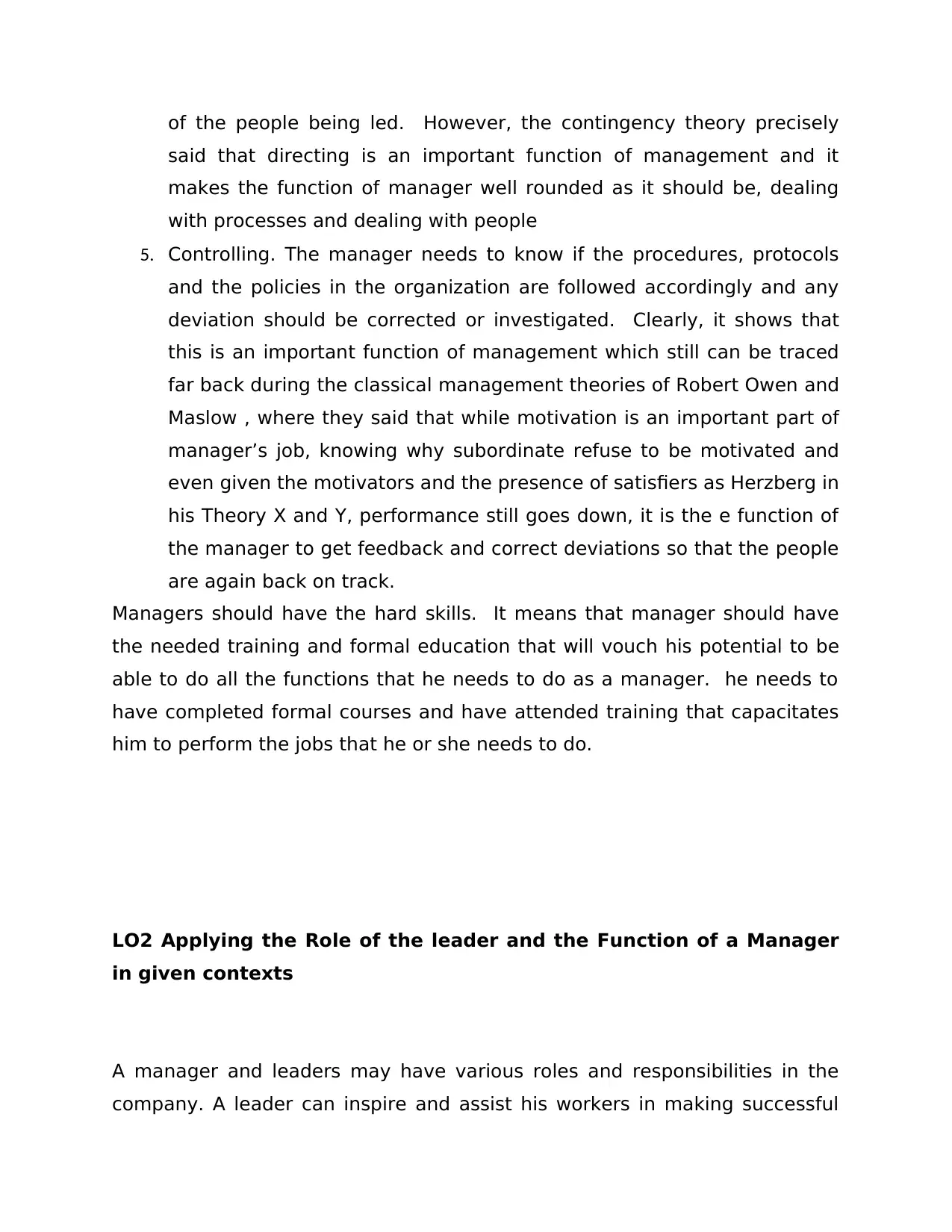
of the people being led. However, the contingency theory precisely
said that directing is an important function of management and it
makes the function of manager well rounded as it should be, dealing
with processes and dealing with people
5. Controlling. The manager needs to know if the procedures, protocols
and the policies in the organization are followed accordingly and any
deviation should be corrected or investigated. Clearly, it shows that
this is an important function of management which still can be traced
far back during the classical management theories of Robert Owen and
Maslow , where they said that while motivation is an important part of
manager’s job, knowing why subordinate refuse to be motivated and
even given the motivators and the presence of satisfiers as Herzberg in
his Theory X and Y, performance still goes down, it is the e function of
the manager to get feedback and correct deviations so that the people
are again back on track.
Managers should have the hard skills. It means that manager should have
the needed training and formal education that will vouch his potential to be
able to do all the functions that he needs to do as a manager. he needs to
have completed formal courses and have attended training that capacitates
him to perform the jobs that he or she needs to do.
LO2 Applying the Role of the leader and the Function of a Manager
in given contexts
A manager and leaders may have various roles and responsibilities in the
company. A leader can inspire and assist his workers in making successful
said that directing is an important function of management and it
makes the function of manager well rounded as it should be, dealing
with processes and dealing with people
5. Controlling. The manager needs to know if the procedures, protocols
and the policies in the organization are followed accordingly and any
deviation should be corrected or investigated. Clearly, it shows that
this is an important function of management which still can be traced
far back during the classical management theories of Robert Owen and
Maslow , where they said that while motivation is an important part of
manager’s job, knowing why subordinate refuse to be motivated and
even given the motivators and the presence of satisfiers as Herzberg in
his Theory X and Y, performance still goes down, it is the e function of
the manager to get feedback and correct deviations so that the people
are again back on track.
Managers should have the hard skills. It means that manager should have
the needed training and formal education that will vouch his potential to be
able to do all the functions that he needs to do as a manager. he needs to
have completed formal courses and have attended training that capacitates
him to perform the jobs that he or she needs to do.
LO2 Applying the Role of the leader and the Function of a Manager
in given contexts
A manager and leaders may have various roles and responsibilities in the
company. A leader can inspire and assist his workers in making successful
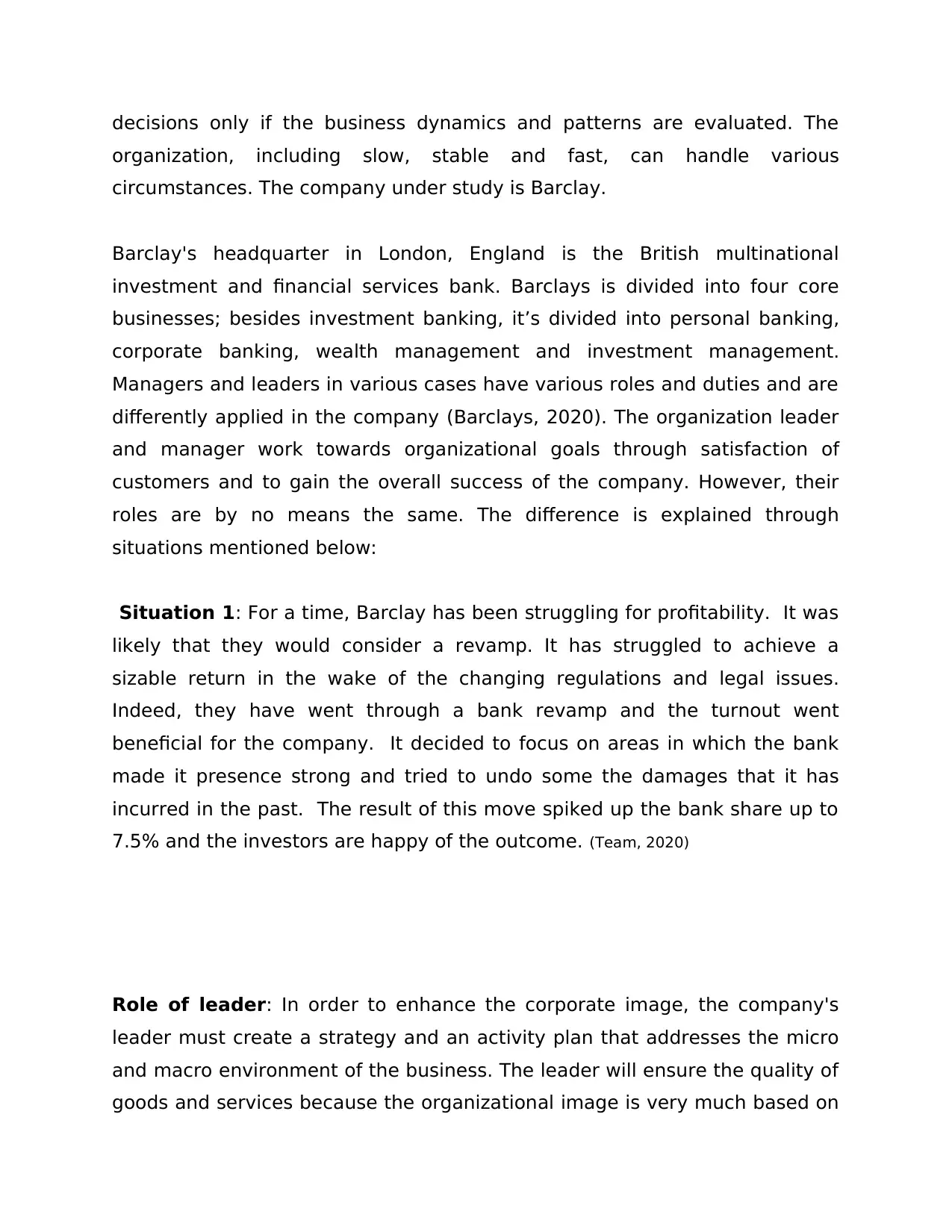
decisions only if the business dynamics and patterns are evaluated. The
organization, including slow, stable and fast, can handle various
circumstances. The company under study is Barclay.
Barclay's headquarter in London, England is the British multinational
investment and financial services bank. Barclays is divided into four core
businesses; besides investment banking, it’s divided into personal banking,
corporate banking, wealth management and investment management.
Managers and leaders in various cases have various roles and duties and are
differently applied in the company (Barclays, 2020). The organization leader
and manager work towards organizational goals through satisfaction of
customers and to gain the overall success of the company. However, their
roles are by no means the same. The difference is explained through
situations mentioned below:
Situation 1: For a time, Barclay has been struggling for profitability. It was
likely that they would consider a revamp. It has struggled to achieve a
sizable return in the wake of the changing regulations and legal issues.
Indeed, they have went through a bank revamp and the turnout went
beneficial for the company. It decided to focus on areas in which the bank
made it presence strong and tried to undo some the damages that it has
incurred in the past. The result of this move spiked up the bank share up to
7.5% and the investors are happy of the outcome. (Team, 2020)
Role of leader: In order to enhance the corporate image, the company's
leader must create a strategy and an activity plan that addresses the micro
and macro environment of the business. The leader will ensure the quality of
goods and services because the organizational image is very much based on
organization, including slow, stable and fast, can handle various
circumstances. The company under study is Barclay.
Barclay's headquarter in London, England is the British multinational
investment and financial services bank. Barclays is divided into four core
businesses; besides investment banking, it’s divided into personal banking,
corporate banking, wealth management and investment management.
Managers and leaders in various cases have various roles and duties and are
differently applied in the company (Barclays, 2020). The organization leader
and manager work towards organizational goals through satisfaction of
customers and to gain the overall success of the company. However, their
roles are by no means the same. The difference is explained through
situations mentioned below:
Situation 1: For a time, Barclay has been struggling for profitability. It was
likely that they would consider a revamp. It has struggled to achieve a
sizable return in the wake of the changing regulations and legal issues.
Indeed, they have went through a bank revamp and the turnout went
beneficial for the company. It decided to focus on areas in which the bank
made it presence strong and tried to undo some the damages that it has
incurred in the past. The result of this move spiked up the bank share up to
7.5% and the investors are happy of the outcome. (Team, 2020)
Role of leader: In order to enhance the corporate image, the company's
leader must create a strategy and an activity plan that addresses the micro
and macro environment of the business. The leader will ensure the quality of
goods and services because the organizational image is very much based on
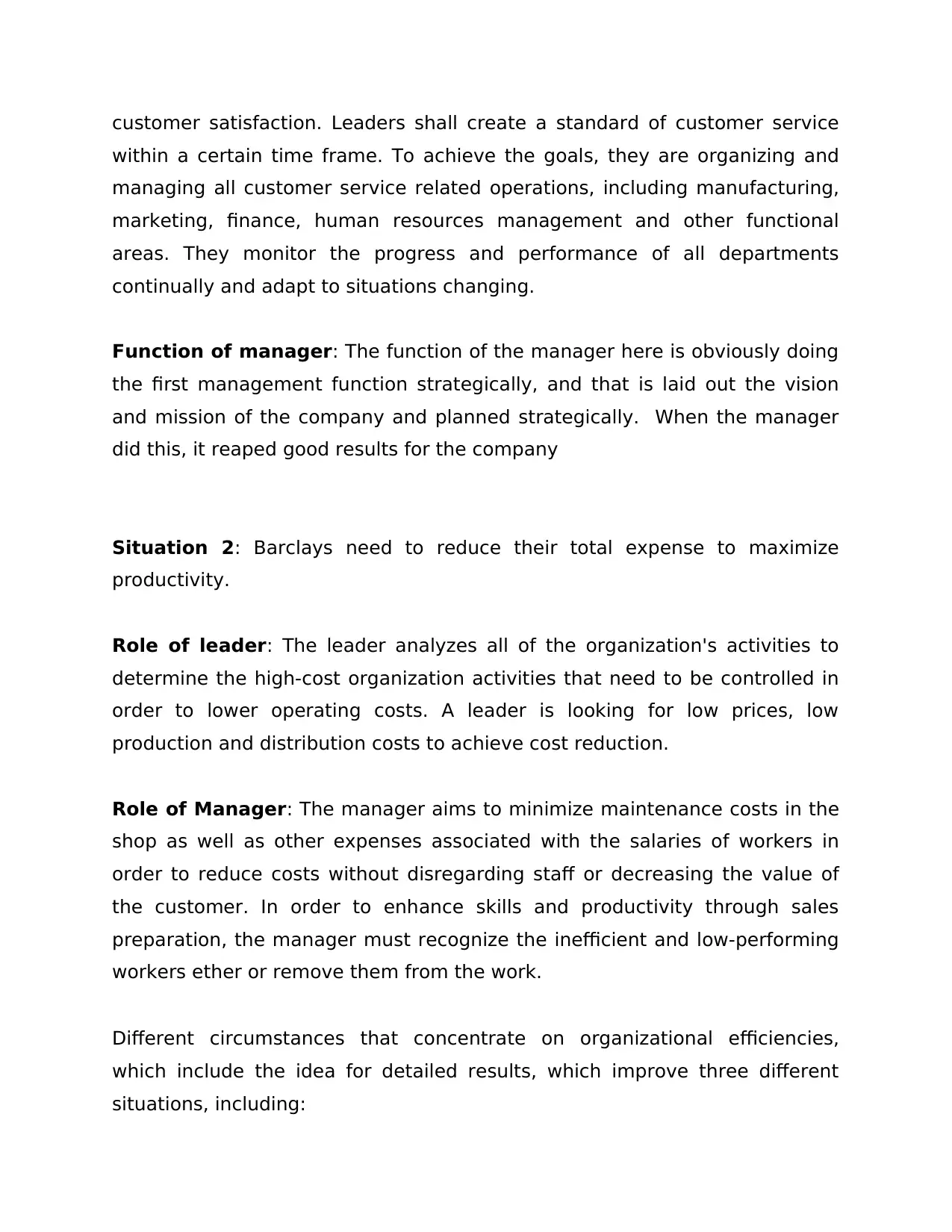
customer satisfaction. Leaders shall create a standard of customer service
within a certain time frame. To achieve the goals, they are organizing and
managing all customer service related operations, including manufacturing,
marketing, finance, human resources management and other functional
areas. They monitor the progress and performance of all departments
continually and adapt to situations changing.
Function of manager: The function of the manager here is obviously doing
the first management function strategically, and that is laid out the vision
and mission of the company and planned strategically. When the manager
did this, it reaped good results for the company
Situation 2: Barclays need to reduce their total expense to maximize
productivity.
Role of leader: The leader analyzes all of the organization's activities to
determine the high-cost organization activities that need to be controlled in
order to lower operating costs. A leader is looking for low prices, low
production and distribution costs to achieve cost reduction.
Role of Manager: The manager aims to minimize maintenance costs in the
shop as well as other expenses associated with the salaries of workers in
order to reduce costs without disregarding staff or decreasing the value of
the customer. In order to enhance skills and productivity through sales
preparation, the manager must recognize the inefficient and low-performing
workers ether or remove them from the work.
Different circumstances that concentrate on organizational efficiencies,
which include the idea for detailed results, which improve three different
situations, including:
within a certain time frame. To achieve the goals, they are organizing and
managing all customer service related operations, including manufacturing,
marketing, finance, human resources management and other functional
areas. They monitor the progress and performance of all departments
continually and adapt to situations changing.
Function of manager: The function of the manager here is obviously doing
the first management function strategically, and that is laid out the vision
and mission of the company and planned strategically. When the manager
did this, it reaped good results for the company
Situation 2: Barclays need to reduce their total expense to maximize
productivity.
Role of leader: The leader analyzes all of the organization's activities to
determine the high-cost organization activities that need to be controlled in
order to lower operating costs. A leader is looking for low prices, low
production and distribution costs to achieve cost reduction.
Role of Manager: The manager aims to minimize maintenance costs in the
shop as well as other expenses associated with the salaries of workers in
order to reduce costs without disregarding staff or decreasing the value of
the customer. In order to enhance skills and productivity through sales
preparation, the manager must recognize the inefficient and low-performing
workers ether or remove them from the work.
Different circumstances that concentrate on organizational efficiencies,
which include the idea for detailed results, which improve three different
situations, including:
Paraphrase This Document
Need a fresh take? Get an instant paraphrase of this document with our AI Paraphraser
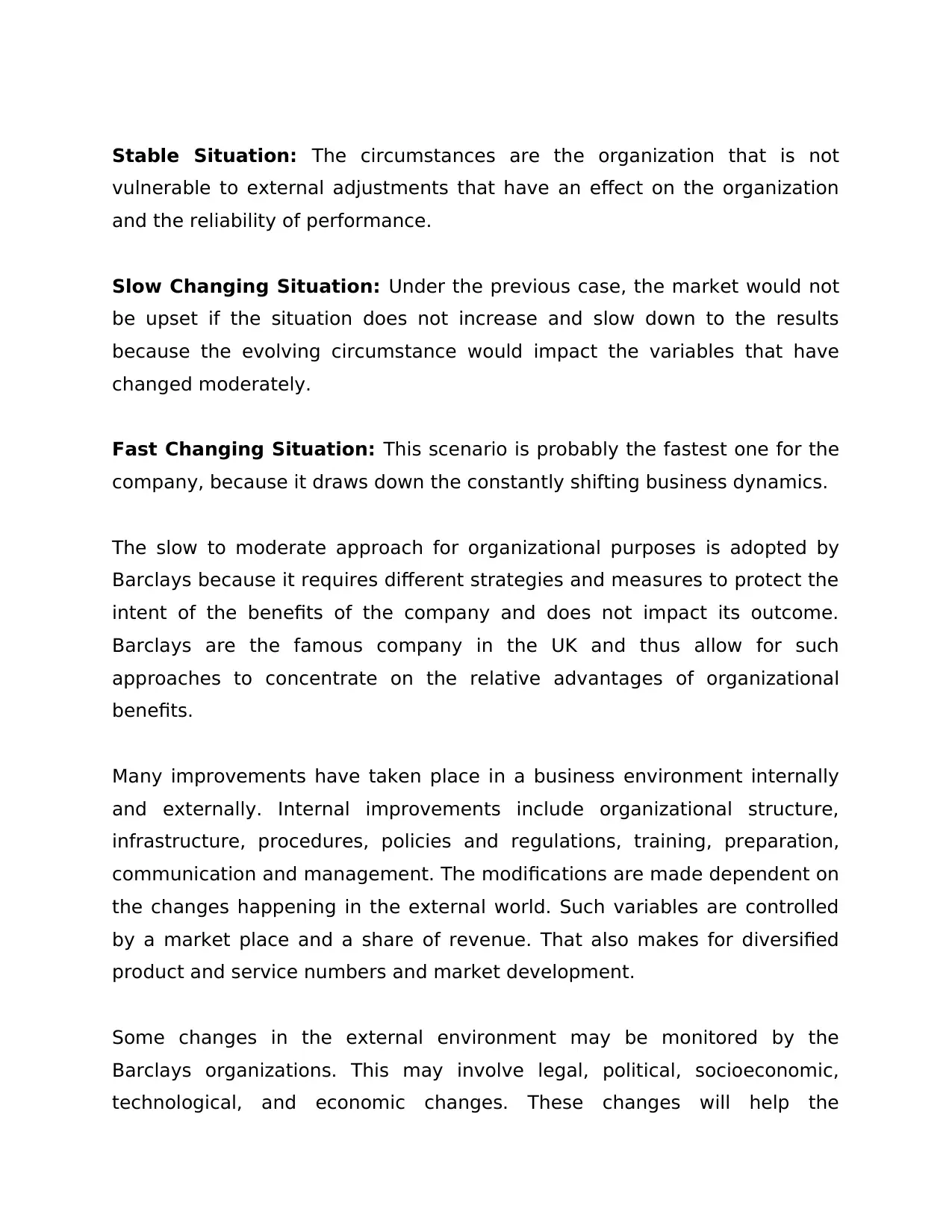
Stable Situation: The circumstances are the organization that is not
vulnerable to external adjustments that have an effect on the organization
and the reliability of performance.
Slow Changing Situation: Under the previous case, the market would not
be upset if the situation does not increase and slow down to the results
because the evolving circumstance would impact the variables that have
changed moderately.
Fast Changing Situation: This scenario is probably the fastest one for the
company, because it draws down the constantly shifting business dynamics.
The slow to moderate approach for organizational purposes is adopted by
Barclays because it requires different strategies and measures to protect the
intent of the benefits of the company and does not impact its outcome.
Barclays are the famous company in the UK and thus allow for such
approaches to concentrate on the relative advantages of organizational
benefits.
Many improvements have taken place in a business environment internally
and externally. Internal improvements include organizational structure,
infrastructure, procedures, policies and regulations, training, preparation,
communication and management. The modifications are made dependent on
the changes happening in the external world. Such variables are controlled
by a market place and a share of revenue. That also makes for diversified
product and service numbers and market development.
Some changes in the external environment may be monitored by the
Barclays organizations. This may involve legal, political, socioeconomic,
technological, and economic changes. These changes will help the
vulnerable to external adjustments that have an effect on the organization
and the reliability of performance.
Slow Changing Situation: Under the previous case, the market would not
be upset if the situation does not increase and slow down to the results
because the evolving circumstance would impact the variables that have
changed moderately.
Fast Changing Situation: This scenario is probably the fastest one for the
company, because it draws down the constantly shifting business dynamics.
The slow to moderate approach for organizational purposes is adopted by
Barclays because it requires different strategies and measures to protect the
intent of the benefits of the company and does not impact its outcome.
Barclays are the famous company in the UK and thus allow for such
approaches to concentrate on the relative advantages of organizational
benefits.
Many improvements have taken place in a business environment internally
and externally. Internal improvements include organizational structure,
infrastructure, procedures, policies and regulations, training, preparation,
communication and management. The modifications are made dependent on
the changes happening in the external world. Such variables are controlled
by a market place and a share of revenue. That also makes for diversified
product and service numbers and market development.
Some changes in the external environment may be monitored by the
Barclays organizations. This may involve legal, political, socioeconomic,
technological, and economic changes. These changes will help the
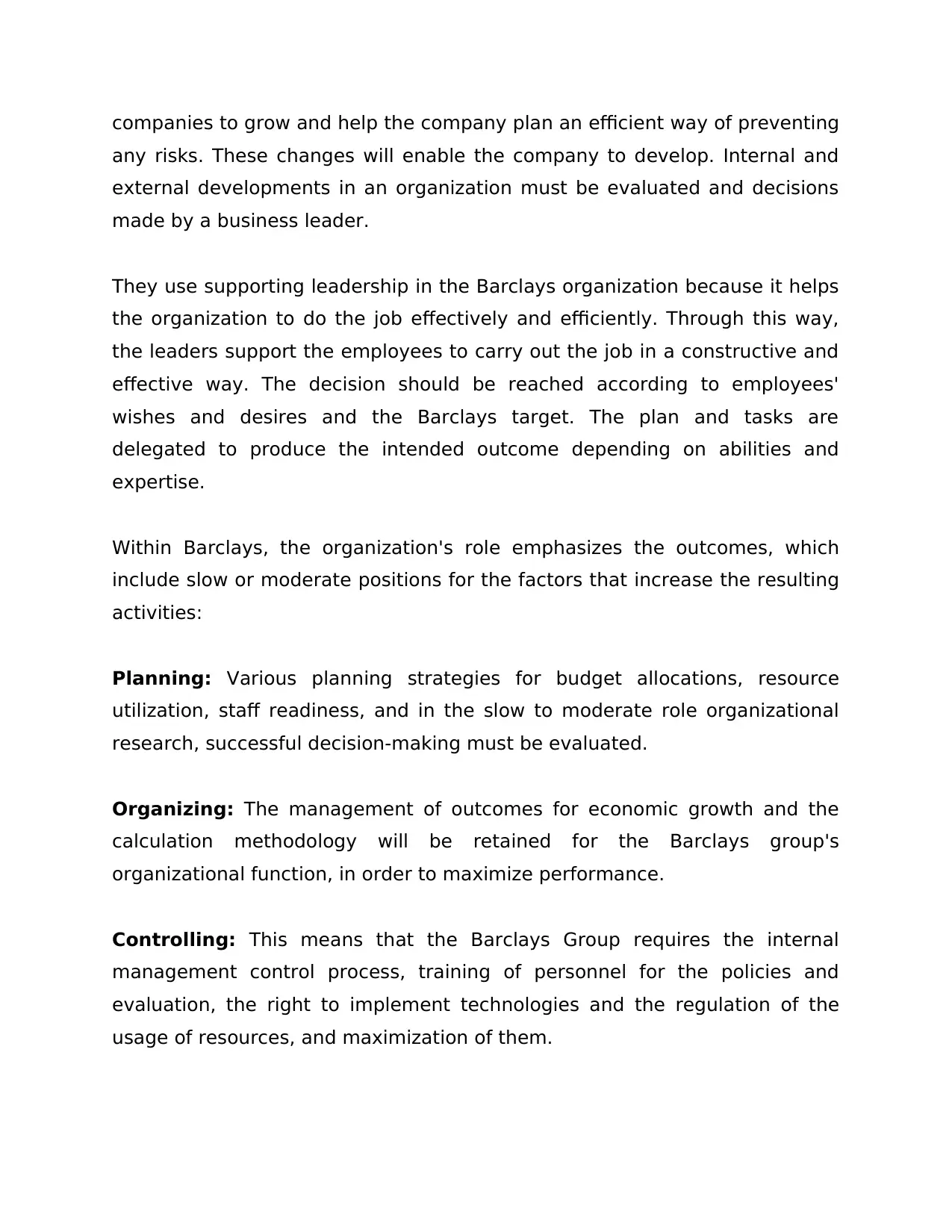
companies to grow and help the company plan an efficient way of preventing
any risks. These changes will enable the company to develop. Internal and
external developments in an organization must be evaluated and decisions
made by a business leader.
They use supporting leadership in the Barclays organization because it helps
the organization to do the job effectively and efficiently. Through this way,
the leaders support the employees to carry out the job in a constructive and
effective way. The decision should be reached according to employees'
wishes and desires and the Barclays target. The plan and tasks are
delegated to produce the intended outcome depending on abilities and
expertise.
Within Barclays, the organization's role emphasizes the outcomes, which
include slow or moderate positions for the factors that increase the resulting
activities:
Planning: Various planning strategies for budget allocations, resource
utilization, staff readiness, and in the slow to moderate role organizational
research, successful decision-making must be evaluated.
Organizing: The management of outcomes for economic growth and the
calculation methodology will be retained for the Barclays group's
organizational function, in order to maximize performance.
Controlling: This means that the Barclays Group requires the internal
management control process, training of personnel for the policies and
evaluation, the right to implement technologies and the regulation of the
usage of resources, and maximization of them.
any risks. These changes will enable the company to develop. Internal and
external developments in an organization must be evaluated and decisions
made by a business leader.
They use supporting leadership in the Barclays organization because it helps
the organization to do the job effectively and efficiently. Through this way,
the leaders support the employees to carry out the job in a constructive and
effective way. The decision should be reached according to employees'
wishes and desires and the Barclays target. The plan and tasks are
delegated to produce the intended outcome depending on abilities and
expertise.
Within Barclays, the organization's role emphasizes the outcomes, which
include slow or moderate positions for the factors that increase the resulting
activities:
Planning: Various planning strategies for budget allocations, resource
utilization, staff readiness, and in the slow to moderate role organizational
research, successful decision-making must be evaluated.
Organizing: The management of outcomes for economic growth and the
calculation methodology will be retained for the Barclays group's
organizational function, in order to maximize performance.
Controlling: This means that the Barclays Group requires the internal
management control process, training of personnel for the policies and
evaluation, the right to implement technologies and the regulation of the
usage of resources, and maximization of them.
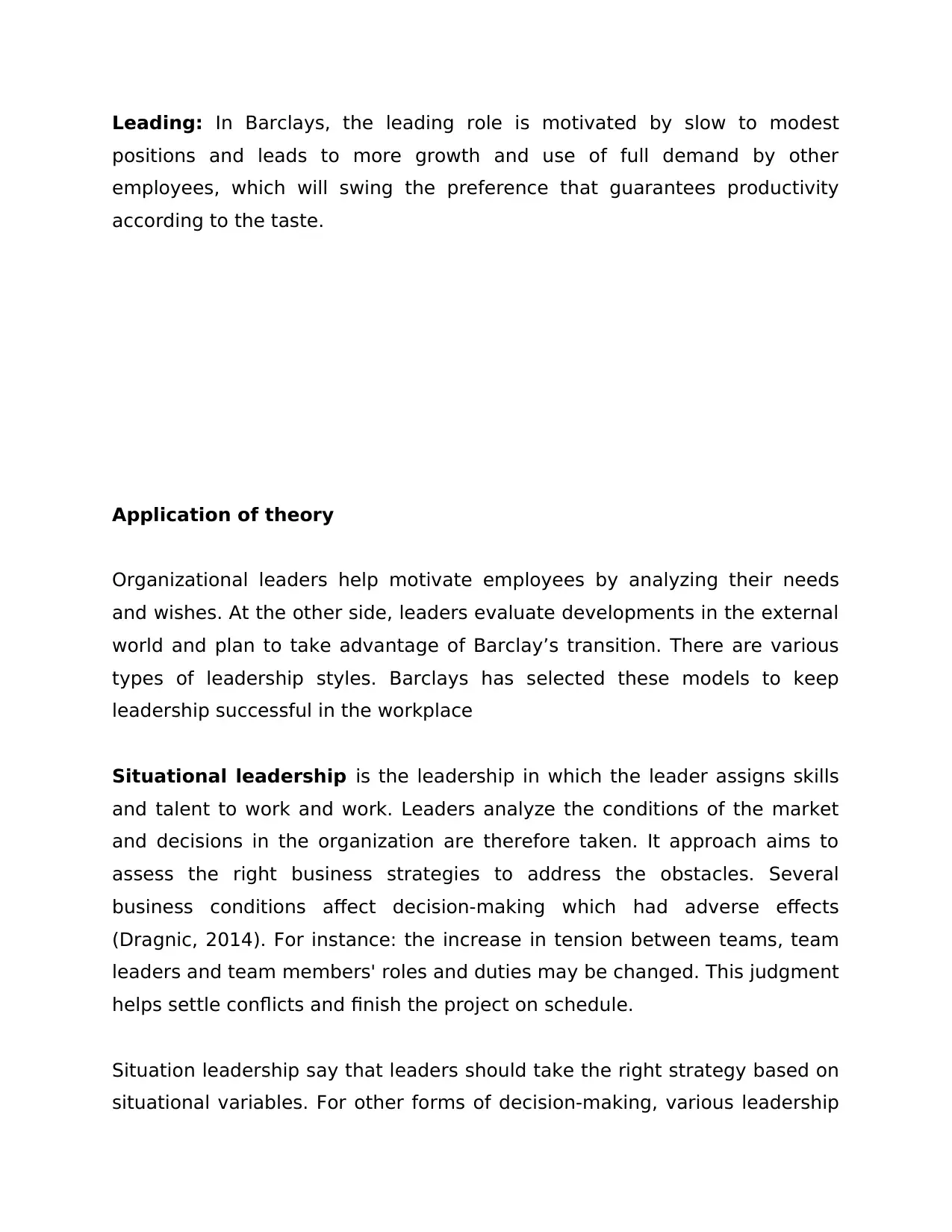
Leading: In Barclays, the leading role is motivated by slow to modest
positions and leads to more growth and use of full demand by other
employees, which will swing the preference that guarantees productivity
according to the taste.
Application of theory
Organizational leaders help motivate employees by analyzing their needs
and wishes. At the other side, leaders evaluate developments in the external
world and plan to take advantage of Barclay’s transition. There are various
types of leadership styles. Barclays has selected these models to keep
leadership successful in the workplace
Situational leadership is the leadership in which the leader assigns skills
and talent to work and work. Leaders analyze the conditions of the market
and decisions in the organization are therefore taken. It approach aims to
assess the right business strategies to address the obstacles. Several
business conditions affect decision-making which had adverse effects
(Dragnic, 2014). For instance: the increase in tension between teams, team
leaders and team members' roles and duties may be changed. This judgment
helps settle conflicts and finish the project on schedule.
Situation leadership say that leaders should take the right strategy based on
situational variables. For other forms of decision-making, various leadership
positions and leads to more growth and use of full demand by other
employees, which will swing the preference that guarantees productivity
according to the taste.
Application of theory
Organizational leaders help motivate employees by analyzing their needs
and wishes. At the other side, leaders evaluate developments in the external
world and plan to take advantage of Barclay’s transition. There are various
types of leadership styles. Barclays has selected these models to keep
leadership successful in the workplace
Situational leadership is the leadership in which the leader assigns skills
and talent to work and work. Leaders analyze the conditions of the market
and decisions in the organization are therefore taken. It approach aims to
assess the right business strategies to address the obstacles. Several
business conditions affect decision-making which had adverse effects
(Dragnic, 2014). For instance: the increase in tension between teams, team
leaders and team members' roles and duties may be changed. This judgment
helps settle conflicts and finish the project on schedule.
Situation leadership say that leaders should take the right strategy based on
situational variables. For other forms of decision-making, various leadership
Secure Best Marks with AI Grader
Need help grading? Try our AI Grader for instant feedback on your assignments.
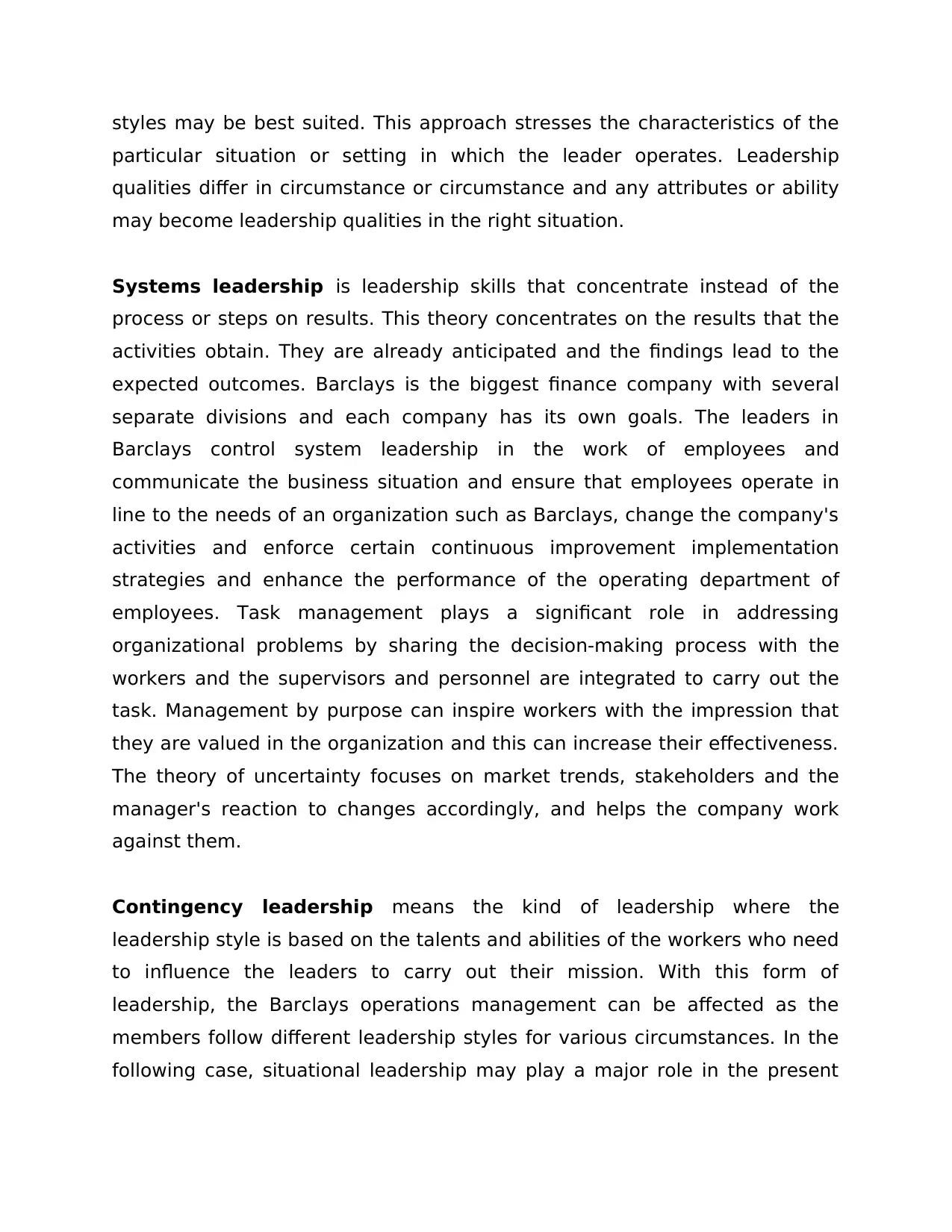
styles may be best suited. This approach stresses the characteristics of the
particular situation or setting in which the leader operates. Leadership
qualities differ in circumstance or circumstance and any attributes or ability
may become leadership qualities in the right situation.
Systems leadership is leadership skills that concentrate instead of the
process or steps on results. This theory concentrates on the results that the
activities obtain. They are already anticipated and the findings lead to the
expected outcomes. Barclays is the biggest finance company with several
separate divisions and each company has its own goals. The leaders in
Barclays control system leadership in the work of employees and
communicate the business situation and ensure that employees operate in
line to the needs of an organization such as Barclays, change the company's
activities and enforce certain continuous improvement implementation
strategies and enhance the performance of the operating department of
employees. Task management plays a significant role in addressing
organizational problems by sharing the decision-making process with the
workers and the supervisors and personnel are integrated to carry out the
task. Management by purpose can inspire workers with the impression that
they are valued in the organization and this can increase their effectiveness.
The theory of uncertainty focuses on market trends, stakeholders and the
manager's reaction to changes accordingly, and helps the company work
against them.
Contingency leadership means the kind of leadership where the
leadership style is based on the talents and abilities of the workers who need
to influence the leaders to carry out their mission. With this form of
leadership, the Barclays operations management can be affected as the
members follow different leadership styles for various circumstances. In the
following case, situational leadership may play a major role in the present
particular situation or setting in which the leader operates. Leadership
qualities differ in circumstance or circumstance and any attributes or ability
may become leadership qualities in the right situation.
Systems leadership is leadership skills that concentrate instead of the
process or steps on results. This theory concentrates on the results that the
activities obtain. They are already anticipated and the findings lead to the
expected outcomes. Barclays is the biggest finance company with several
separate divisions and each company has its own goals. The leaders in
Barclays control system leadership in the work of employees and
communicate the business situation and ensure that employees operate in
line to the needs of an organization such as Barclays, change the company's
activities and enforce certain continuous improvement implementation
strategies and enhance the performance of the operating department of
employees. Task management plays a significant role in addressing
organizational problems by sharing the decision-making process with the
workers and the supervisors and personnel are integrated to carry out the
task. Management by purpose can inspire workers with the impression that
they are valued in the organization and this can increase their effectiveness.
The theory of uncertainty focuses on market trends, stakeholders and the
manager's reaction to changes accordingly, and helps the company work
against them.
Contingency leadership means the kind of leadership where the
leadership style is based on the talents and abilities of the workers who need
to influence the leaders to carry out their mission. With this form of
leadership, the Barclays operations management can be affected as the
members follow different leadership styles for various circumstances. In the
following case, situational leadership may play a major role in the present
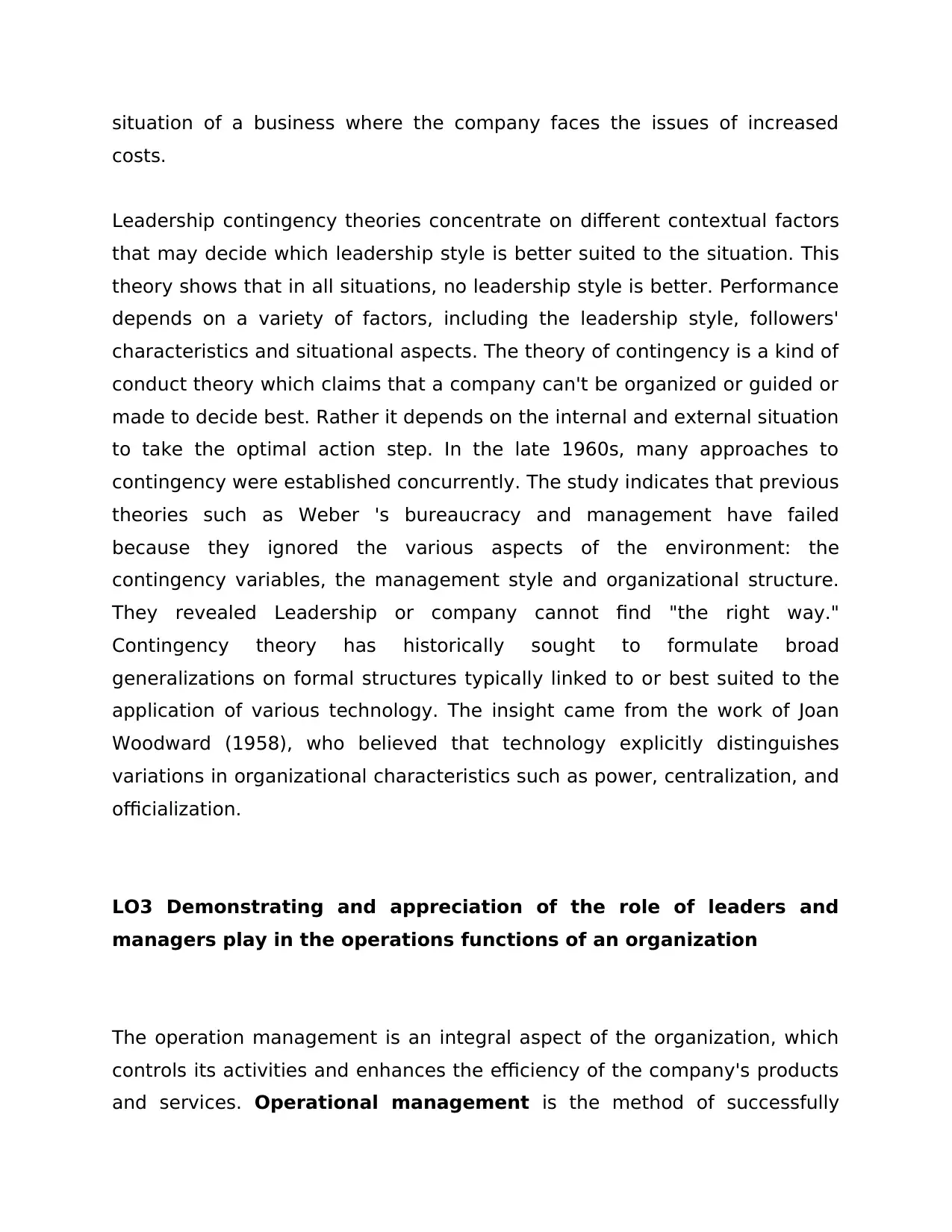
situation of a business where the company faces the issues of increased
costs.
Leadership contingency theories concentrate on different contextual factors
that may decide which leadership style is better suited to the situation. This
theory shows that in all situations, no leadership style is better. Performance
depends on a variety of factors, including the leadership style, followers'
characteristics and situational aspects. The theory of contingency is a kind of
conduct theory which claims that a company can't be organized or guided or
made to decide best. Rather it depends on the internal and external situation
to take the optimal action step. In the late 1960s, many approaches to
contingency were established concurrently. The study indicates that previous
theories such as Weber 's bureaucracy and management have failed
because they ignored the various aspects of the environment: the
contingency variables, the management style and organizational structure.
They revealed Leadership or company cannot find "the right way."
Contingency theory has historically sought to formulate broad
generalizations on formal structures typically linked to or best suited to the
application of various technology. The insight came from the work of Joan
Woodward (1958), who believed that technology explicitly distinguishes
variations in organizational characteristics such as power, centralization, and
officialization.
LO3 Demonstrating and appreciation of the role of leaders and
managers play in the operations functions of an organization
The operation management is an integral aspect of the organization, which
controls its activities and enhances the efficiency of the company's products
and services. Operational management is the method of successfully
costs.
Leadership contingency theories concentrate on different contextual factors
that may decide which leadership style is better suited to the situation. This
theory shows that in all situations, no leadership style is better. Performance
depends on a variety of factors, including the leadership style, followers'
characteristics and situational aspects. The theory of contingency is a kind of
conduct theory which claims that a company can't be organized or guided or
made to decide best. Rather it depends on the internal and external situation
to take the optimal action step. In the late 1960s, many approaches to
contingency were established concurrently. The study indicates that previous
theories such as Weber 's bureaucracy and management have failed
because they ignored the various aspects of the environment: the
contingency variables, the management style and organizational structure.
They revealed Leadership or company cannot find "the right way."
Contingency theory has historically sought to formulate broad
generalizations on formal structures typically linked to or best suited to the
application of various technology. The insight came from the work of Joan
Woodward (1958), who believed that technology explicitly distinguishes
variations in organizational characteristics such as power, centralization, and
officialization.
LO3 Demonstrating and appreciation of the role of leaders and
managers play in the operations functions of an organization
The operation management is an integral aspect of the organization, which
controls its activities and enhances the efficiency of the company's products
and services. Operational management is the method of successfully
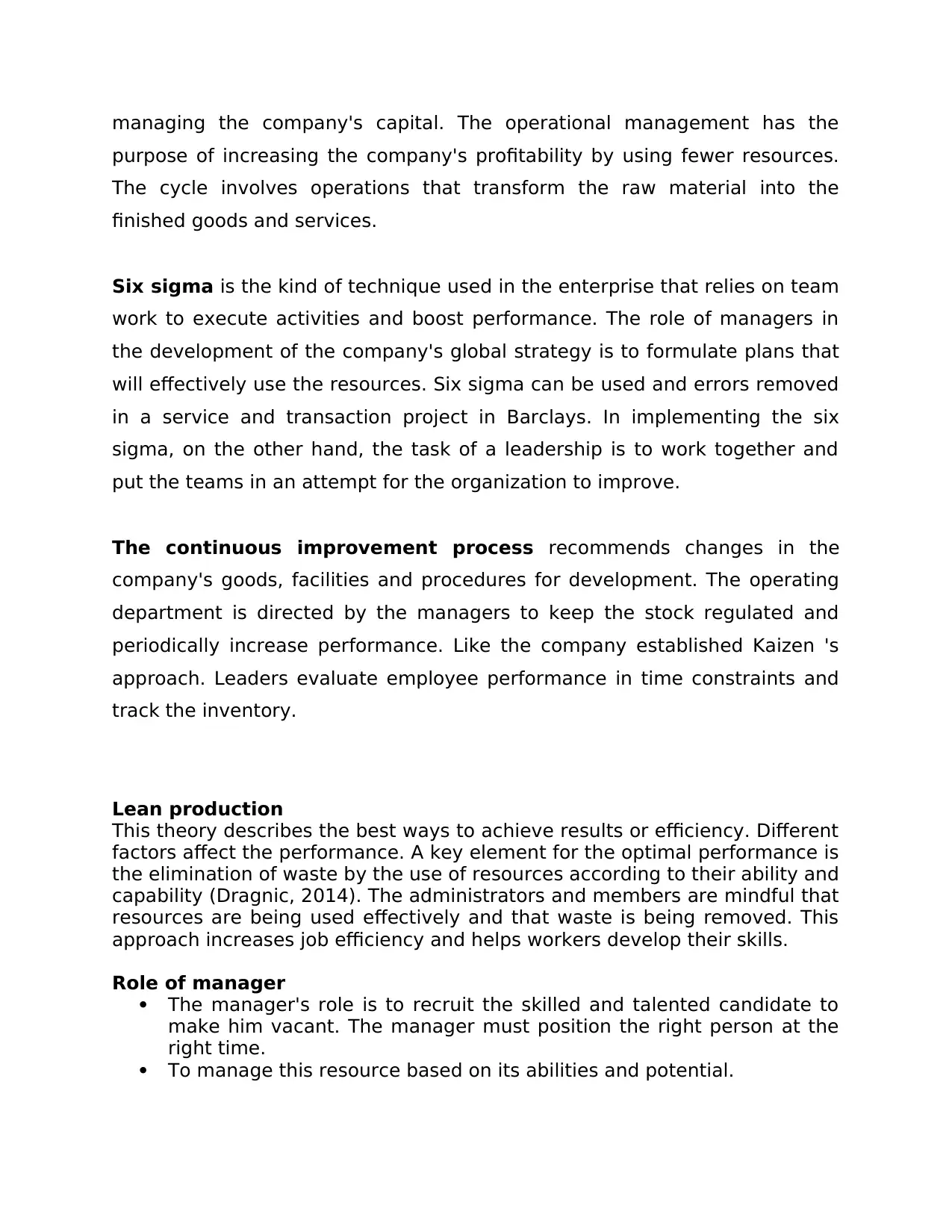
managing the company's capital. The operational management has the
purpose of increasing the company's profitability by using fewer resources.
The cycle involves operations that transform the raw material into the
finished goods and services.
Six sigma is the kind of technique used in the enterprise that relies on team
work to execute activities and boost performance. The role of managers in
the development of the company's global strategy is to formulate plans that
will effectively use the resources. Six sigma can be used and errors removed
in a service and transaction project in Barclays. In implementing the six
sigma, on the other hand, the task of a leadership is to work together and
put the teams in an attempt for the organization to improve.
The continuous improvement process recommends changes in the
company's goods, facilities and procedures for development. The operating
department is directed by the managers to keep the stock regulated and
periodically increase performance. Like the company established Kaizen 's
approach. Leaders evaluate employee performance in time constraints and
track the inventory.
Lean production
This theory describes the best ways to achieve results or efficiency. Different
factors affect the performance. A key element for the optimal performance is
the elimination of waste by the use of resources according to their ability and
capability (Dragnic, 2014). The administrators and members are mindful that
resources are being used effectively and that waste is being removed. This
approach increases job efficiency and helps workers develop their skills.
Role of manager
The manager's role is to recruit the skilled and talented candidate to
make him vacant. The manager must position the right person at the
right time.
To manage this resource based on its abilities and potential.
purpose of increasing the company's profitability by using fewer resources.
The cycle involves operations that transform the raw material into the
finished goods and services.
Six sigma is the kind of technique used in the enterprise that relies on team
work to execute activities and boost performance. The role of managers in
the development of the company's global strategy is to formulate plans that
will effectively use the resources. Six sigma can be used and errors removed
in a service and transaction project in Barclays. In implementing the six
sigma, on the other hand, the task of a leadership is to work together and
put the teams in an attempt for the organization to improve.
The continuous improvement process recommends changes in the
company's goods, facilities and procedures for development. The operating
department is directed by the managers to keep the stock regulated and
periodically increase performance. Like the company established Kaizen 's
approach. Leaders evaluate employee performance in time constraints and
track the inventory.
Lean production
This theory describes the best ways to achieve results or efficiency. Different
factors affect the performance. A key element for the optimal performance is
the elimination of waste by the use of resources according to their ability and
capability (Dragnic, 2014). The administrators and members are mindful that
resources are being used effectively and that waste is being removed. This
approach increases job efficiency and helps workers develop their skills.
Role of manager
The manager's role is to recruit the skilled and talented candidate to
make him vacant. The manager must position the right person at the
right time.
To manage this resource based on its abilities and potential.
Paraphrase This Document
Need a fresh take? Get an instant paraphrase of this document with our AI Paraphraser
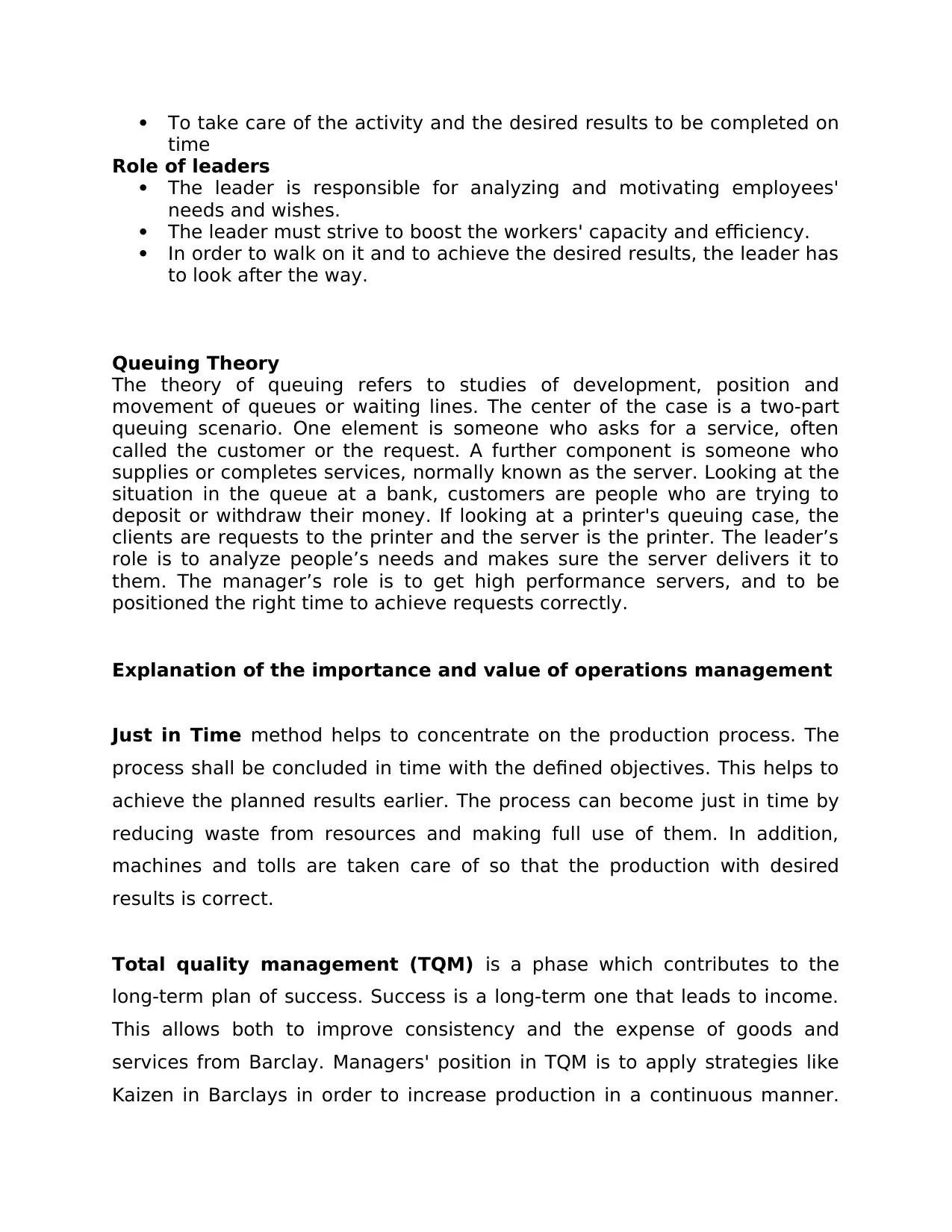
To take care of the activity and the desired results to be completed on
time
Role of leaders
The leader is responsible for analyzing and motivating employees'
needs and wishes.
The leader must strive to boost the workers' capacity and efficiency.
In order to walk on it and to achieve the desired results, the leader has
to look after the way.
Queuing Theory
The theory of queuing refers to studies of development, position and
movement of queues or waiting lines. The center of the case is a two-part
queuing scenario. One element is someone who asks for a service, often
called the customer or the request. A further component is someone who
supplies or completes services, normally known as the server. Looking at the
situation in the queue at a bank, customers are people who are trying to
deposit or withdraw their money. If looking at a printer's queuing case, the
clients are requests to the printer and the server is the printer. The leader’s
role is to analyze people’s needs and makes sure the server delivers it to
them. The manager’s role is to get high performance servers, and to be
positioned the right time to achieve requests correctly.
Explanation of the importance and value of operations management
Just in Time method helps to concentrate on the production process. The
process shall be concluded in time with the defined objectives. This helps to
achieve the planned results earlier. The process can become just in time by
reducing waste from resources and making full use of them. In addition,
machines and tolls are taken care of so that the production with desired
results is correct.
Total quality management (TQM) is a phase which contributes to the
long-term plan of success. Success is a long-term one that leads to income.
This allows both to improve consistency and the expense of goods and
services from Barclay. Managers' position in TQM is to apply strategies like
Kaizen in Barclays in order to increase production in a continuous manner.
time
Role of leaders
The leader is responsible for analyzing and motivating employees'
needs and wishes.
The leader must strive to boost the workers' capacity and efficiency.
In order to walk on it and to achieve the desired results, the leader has
to look after the way.
Queuing Theory
The theory of queuing refers to studies of development, position and
movement of queues or waiting lines. The center of the case is a two-part
queuing scenario. One element is someone who asks for a service, often
called the customer or the request. A further component is someone who
supplies or completes services, normally known as the server. Looking at the
situation in the queue at a bank, customers are people who are trying to
deposit or withdraw their money. If looking at a printer's queuing case, the
clients are requests to the printer and the server is the printer. The leader’s
role is to analyze people’s needs and makes sure the server delivers it to
them. The manager’s role is to get high performance servers, and to be
positioned the right time to achieve requests correctly.
Explanation of the importance and value of operations management
Just in Time method helps to concentrate on the production process. The
process shall be concluded in time with the defined objectives. This helps to
achieve the planned results earlier. The process can become just in time by
reducing waste from resources and making full use of them. In addition,
machines and tolls are taken care of so that the production with desired
results is correct.
Total quality management (TQM) is a phase which contributes to the
long-term plan of success. Success is a long-term one that leads to income.
This allows both to improve consistency and the expense of goods and
services from Barclay. Managers' position in TQM is to apply strategies like
Kaizen in Barclays in order to increase production in a continuous manner.
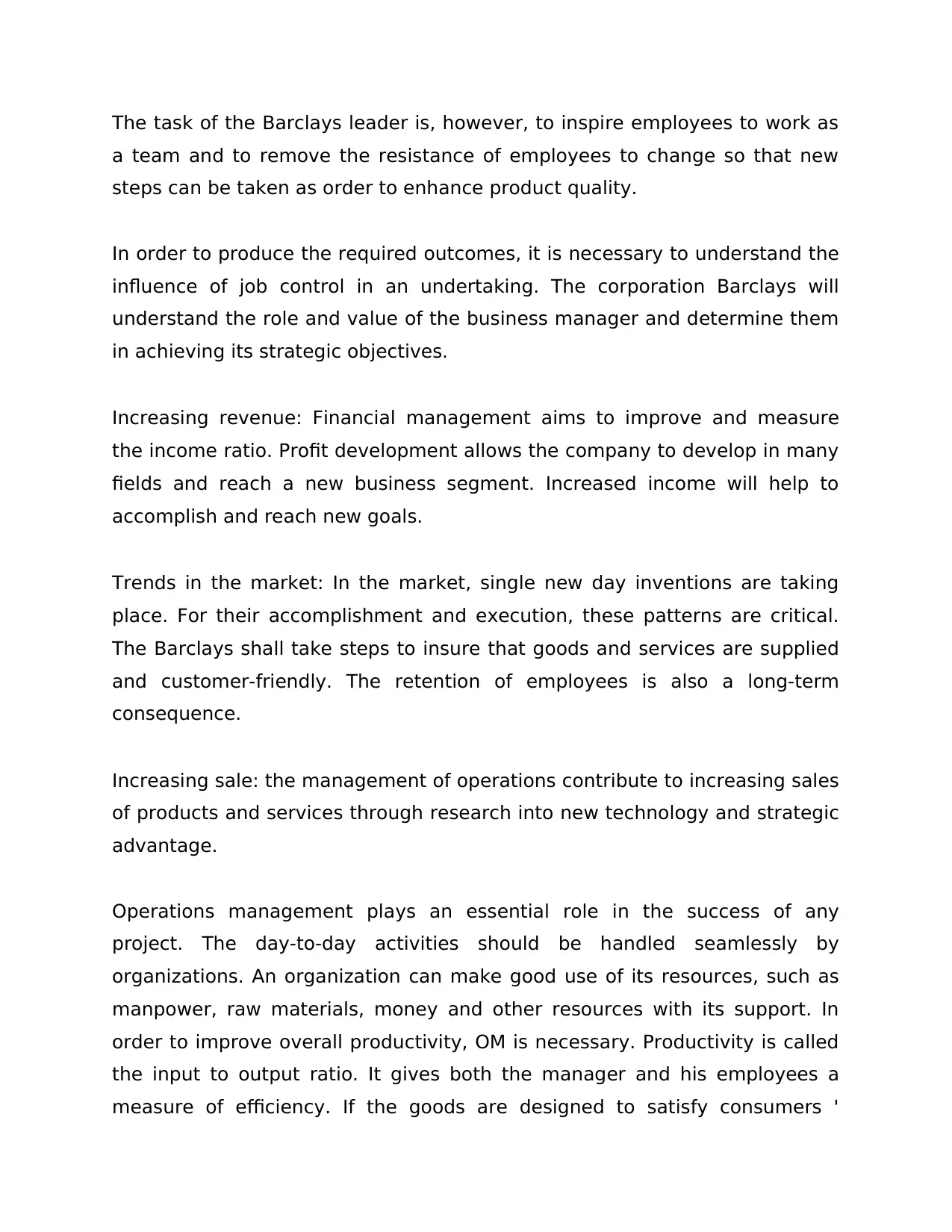
The task of the Barclays leader is, however, to inspire employees to work as
a team and to remove the resistance of employees to change so that new
steps can be taken as order to enhance product quality.
In order to produce the required outcomes, it is necessary to understand the
influence of job control in an undertaking. The corporation Barclays will
understand the role and value of the business manager and determine them
in achieving its strategic objectives.
Increasing revenue: Financial management aims to improve and measure
the income ratio. Profit development allows the company to develop in many
fields and reach a new business segment. Increased income will help to
accomplish and reach new goals.
Trends in the market: In the market, single new day inventions are taking
place. For their accomplishment and execution, these patterns are critical.
The Barclays shall take steps to insure that goods and services are supplied
and customer-friendly. The retention of employees is also a long-term
consequence.
Increasing sale: the management of operations contribute to increasing sales
of products and services through research into new technology and strategic
advantage.
Operations management plays an essential role in the success of any
project. The day-to-day activities should be handled seamlessly by
organizations. An organization can make good use of its resources, such as
manpower, raw materials, money and other resources with its support. In
order to improve overall productivity, OM is necessary. Productivity is called
the input to output ratio. It gives both the manager and his employees a
measure of efficiency. If the goods are designed to satisfy consumers '
a team and to remove the resistance of employees to change so that new
steps can be taken as order to enhance product quality.
In order to produce the required outcomes, it is necessary to understand the
influence of job control in an undertaking. The corporation Barclays will
understand the role and value of the business manager and determine them
in achieving its strategic objectives.
Increasing revenue: Financial management aims to improve and measure
the income ratio. Profit development allows the company to develop in many
fields and reach a new business segment. Increased income will help to
accomplish and reach new goals.
Trends in the market: In the market, single new day inventions are taking
place. For their accomplishment and execution, these patterns are critical.
The Barclays shall take steps to insure that goods and services are supplied
and customer-friendly. The retention of employees is also a long-term
consequence.
Increasing sale: the management of operations contribute to increasing sales
of products and services through research into new technology and strategic
advantage.
Operations management plays an essential role in the success of any
project. The day-to-day activities should be handled seamlessly by
organizations. An organization can make good use of its resources, such as
manpower, raw materials, money and other resources with its support. In
order to improve overall productivity, OM is necessary. Productivity is called
the input to output ratio. It gives both the manager and his employees a
measure of efficiency. If the goods are designed to satisfy consumers '
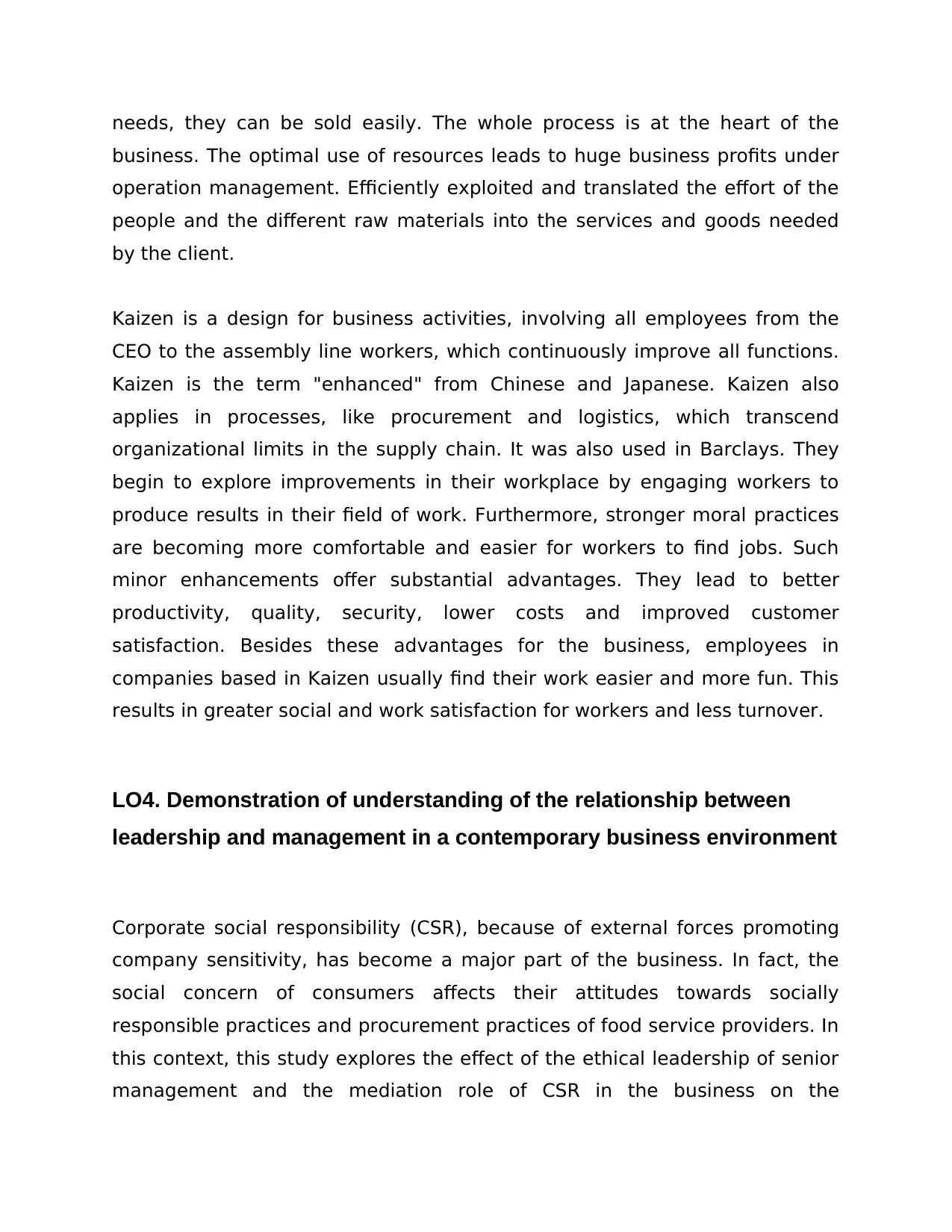
needs, they can be sold easily. The whole process is at the heart of the
business. The optimal use of resources leads to huge business profits under
operation management. Efficiently exploited and translated the effort of the
people and the different raw materials into the services and goods needed
by the client.
Kaizen is a design for business activities, involving all employees from the
CEO to the assembly line workers, which continuously improve all functions.
Kaizen is the term "enhanced" from Chinese and Japanese. Kaizen also
applies in processes, like procurement and logistics, which transcend
organizational limits in the supply chain. It was also used in Barclays. They
begin to explore improvements in their workplace by engaging workers to
produce results in their field of work. Furthermore, stronger moral practices
are becoming more comfortable and easier for workers to find jobs. Such
minor enhancements offer substantial advantages. They lead to better
productivity, quality, security, lower costs and improved customer
satisfaction. Besides these advantages for the business, employees in
companies based in Kaizen usually find their work easier and more fun. This
results in greater social and work satisfaction for workers and less turnover.
LO4. Demonstration of understanding of the relationship between
leadership and management in a contemporary business environment
Corporate social responsibility (CSR), because of external forces promoting
company sensitivity, has become a major part of the business. In fact, the
social concern of consumers affects their attitudes towards socially
responsible practices and procurement practices of food service providers. In
this context, this study explores the effect of the ethical leadership of senior
management and the mediation role of CSR in the business on the
business. The optimal use of resources leads to huge business profits under
operation management. Efficiently exploited and translated the effort of the
people and the different raw materials into the services and goods needed
by the client.
Kaizen is a design for business activities, involving all employees from the
CEO to the assembly line workers, which continuously improve all functions.
Kaizen is the term "enhanced" from Chinese and Japanese. Kaizen also
applies in processes, like procurement and logistics, which transcend
organizational limits in the supply chain. It was also used in Barclays. They
begin to explore improvements in their workplace by engaging workers to
produce results in their field of work. Furthermore, stronger moral practices
are becoming more comfortable and easier for workers to find jobs. Such
minor enhancements offer substantial advantages. They lead to better
productivity, quality, security, lower costs and improved customer
satisfaction. Besides these advantages for the business, employees in
companies based in Kaizen usually find their work easier and more fun. This
results in greater social and work satisfaction for workers and less turnover.
LO4. Demonstration of understanding of the relationship between
leadership and management in a contemporary business environment
Corporate social responsibility (CSR), because of external forces promoting
company sensitivity, has become a major part of the business. In fact, the
social concern of consumers affects their attitudes towards socially
responsible practices and procurement practices of food service providers. In
this context, this study explores the effect of the ethical leadership of senior
management and the mediation role of CSR in the business on the
Secure Best Marks with AI Grader
Need help grading? Try our AI Grader for instant feedback on your assignments.
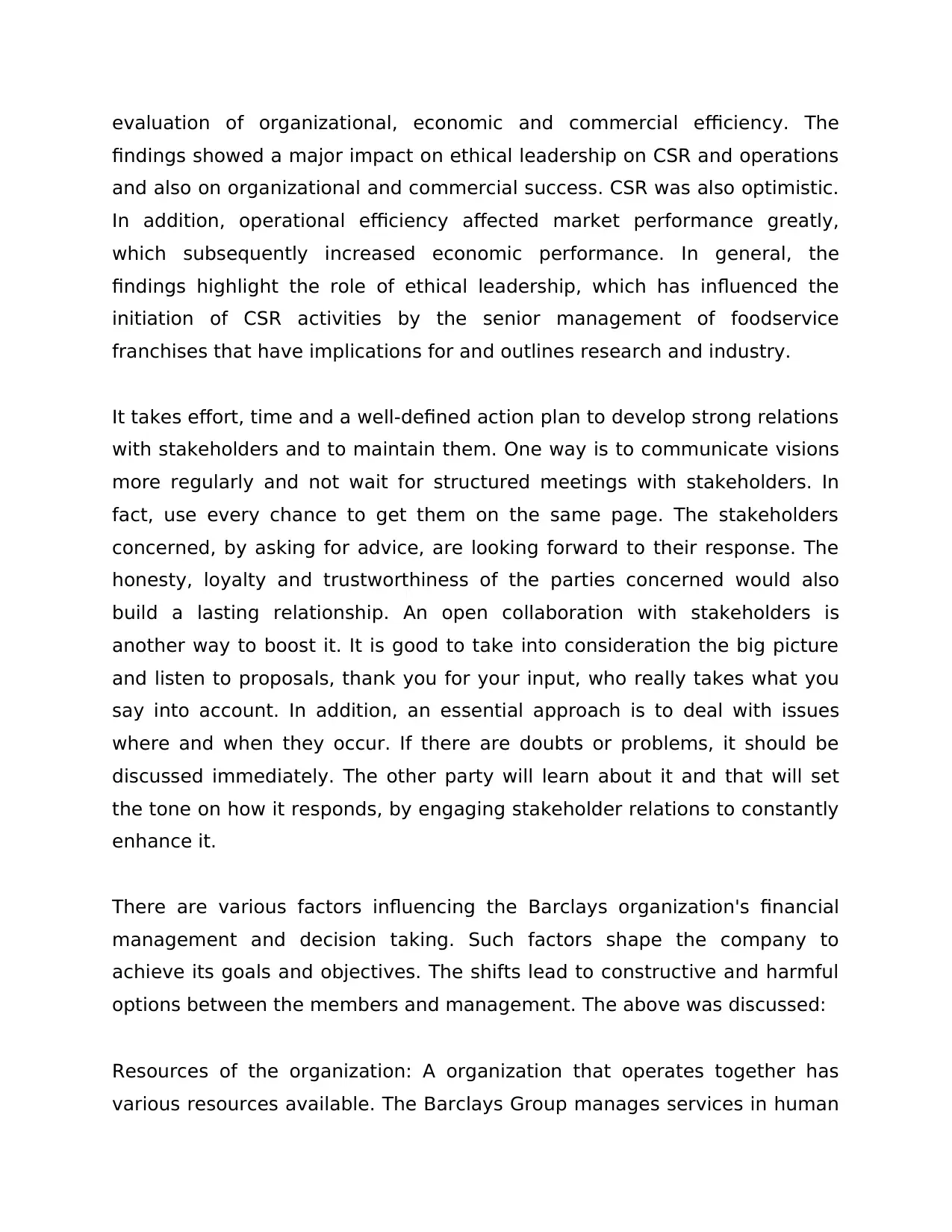
evaluation of organizational, economic and commercial efficiency. The
findings showed a major impact on ethical leadership on CSR and operations
and also on organizational and commercial success. CSR was also optimistic.
In addition, operational efficiency affected market performance greatly,
which subsequently increased economic performance. In general, the
findings highlight the role of ethical leadership, which has influenced the
initiation of CSR activities by the senior management of foodservice
franchises that have implications for and outlines research and industry.
It takes effort, time and a well-defined action plan to develop strong relations
with stakeholders and to maintain them. One way is to communicate visions
more regularly and not wait for structured meetings with stakeholders. In
fact, use every chance to get them on the same page. The stakeholders
concerned, by asking for advice, are looking forward to their response. The
honesty, loyalty and trustworthiness of the parties concerned would also
build a lasting relationship. An open collaboration with stakeholders is
another way to boost it. It is good to take into consideration the big picture
and listen to proposals, thank you for your input, who really takes what you
say into account. In addition, an essential approach is to deal with issues
where and when they occur. If there are doubts or problems, it should be
discussed immediately. The other party will learn about it and that will set
the tone on how it responds, by engaging stakeholder relations to constantly
enhance it.
There are various factors influencing the Barclays organization's financial
management and decision taking. Such factors shape the company to
achieve its goals and objectives. The shifts lead to constructive and harmful
options between the members and management. The above was discussed:
Resources of the organization: A organization that operates together has
various resources available. The Barclays Group manages services in human
findings showed a major impact on ethical leadership on CSR and operations
and also on organizational and commercial success. CSR was also optimistic.
In addition, operational efficiency affected market performance greatly,
which subsequently increased economic performance. In general, the
findings highlight the role of ethical leadership, which has influenced the
initiation of CSR activities by the senior management of foodservice
franchises that have implications for and outlines research and industry.
It takes effort, time and a well-defined action plan to develop strong relations
with stakeholders and to maintain them. One way is to communicate visions
more regularly and not wait for structured meetings with stakeholders. In
fact, use every chance to get them on the same page. The stakeholders
concerned, by asking for advice, are looking forward to their response. The
honesty, loyalty and trustworthiness of the parties concerned would also
build a lasting relationship. An open collaboration with stakeholders is
another way to boost it. It is good to take into consideration the big picture
and listen to proposals, thank you for your input, who really takes what you
say into account. In addition, an essential approach is to deal with issues
where and when they occur. If there are doubts or problems, it should be
discussed immediately. The other party will learn about it and that will set
the tone on how it responds, by engaging stakeholder relations to constantly
enhance it.
There are various factors influencing the Barclays organization's financial
management and decision taking. Such factors shape the company to
achieve its goals and objectives. The shifts lead to constructive and harmful
options between the members and management. The above was discussed:
Resources of the organization: A organization that operates together has
various resources available. The Barclays Group manages services in human
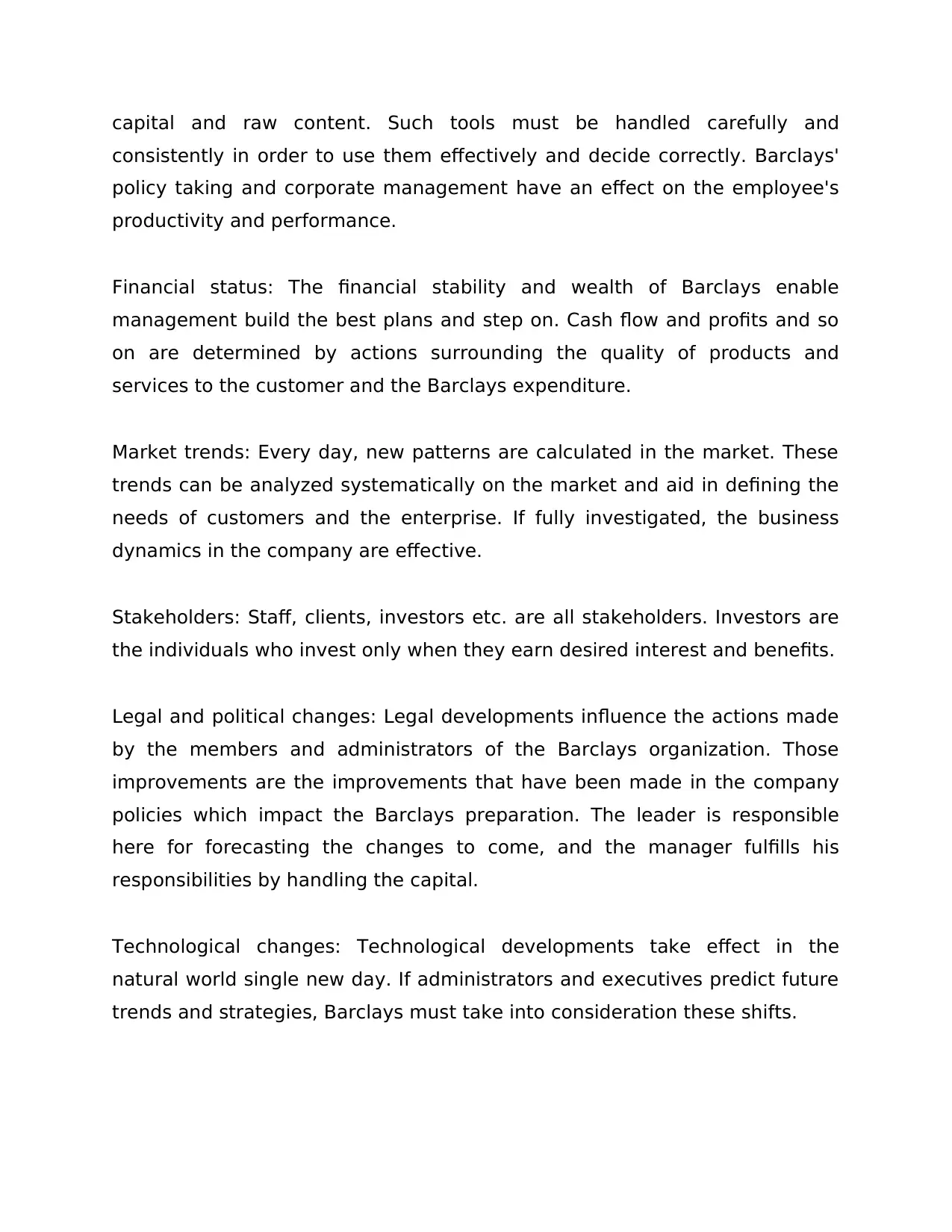
capital and raw content. Such tools must be handled carefully and
consistently in order to use them effectively and decide correctly. Barclays'
policy taking and corporate management have an effect on the employee's
productivity and performance.
Financial status: The financial stability and wealth of Barclays enable
management build the best plans and step on. Cash flow and profits and so
on are determined by actions surrounding the quality of products and
services to the customer and the Barclays expenditure.
Market trends: Every day, new patterns are calculated in the market. These
trends can be analyzed systematically on the market and aid in defining the
needs of customers and the enterprise. If fully investigated, the business
dynamics in the company are effective.
Stakeholders: Staff, clients, investors etc. are all stakeholders. Investors are
the individuals who invest only when they earn desired interest and benefits.
Legal and political changes: Legal developments influence the actions made
by the members and administrators of the Barclays organization. Those
improvements are the improvements that have been made in the company
policies which impact the Barclays preparation. The leader is responsible
here for forecasting the changes to come, and the manager fulfills his
responsibilities by handling the capital.
Technological changes: Technological developments take effect in the
natural world single new day. If administrators and executives predict future
trends and strategies, Barclays must take into consideration these shifts.
consistently in order to use them effectively and decide correctly. Barclays'
policy taking and corporate management have an effect on the employee's
productivity and performance.
Financial status: The financial stability and wealth of Barclays enable
management build the best plans and step on. Cash flow and profits and so
on are determined by actions surrounding the quality of products and
services to the customer and the Barclays expenditure.
Market trends: Every day, new patterns are calculated in the market. These
trends can be analyzed systematically on the market and aid in defining the
needs of customers and the enterprise. If fully investigated, the business
dynamics in the company are effective.
Stakeholders: Staff, clients, investors etc. are all stakeholders. Investors are
the individuals who invest only when they earn desired interest and benefits.
Legal and political changes: Legal developments influence the actions made
by the members and administrators of the Barclays organization. Those
improvements are the improvements that have been made in the company
policies which impact the Barclays preparation. The leader is responsible
here for forecasting the changes to come, and the manager fulfills his
responsibilities by handling the capital.
Technological changes: Technological developments take effect in the
natural world single new day. If administrators and executives predict future
trends and strategies, Barclays must take into consideration these shifts.
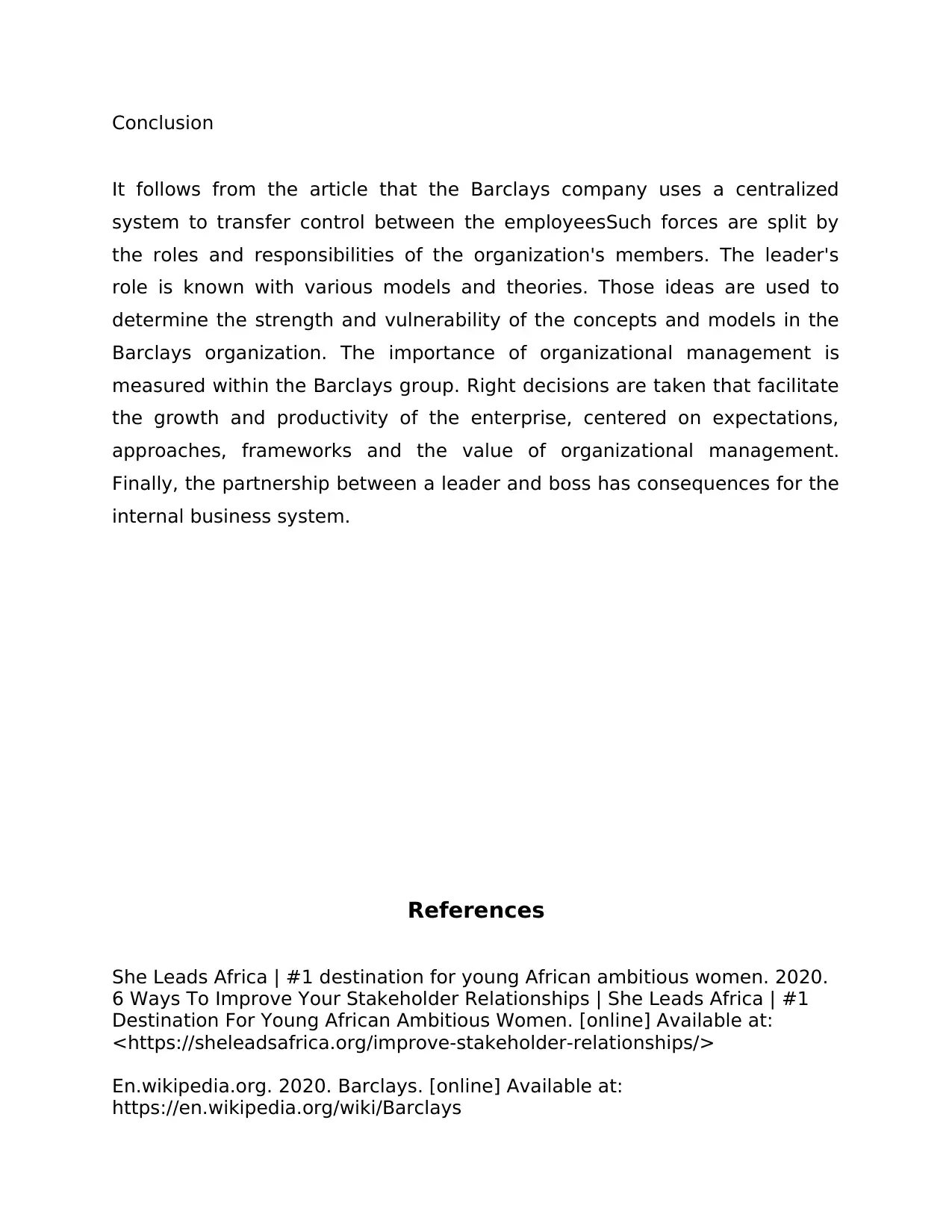
Conclusion
It follows from the article that the Barclays company uses a centralized
system to transfer control between the employeesSuch forces are split by
the roles and responsibilities of the organization's members. The leader's
role is known with various models and theories. Those ideas are used to
determine the strength and vulnerability of the concepts and models in the
Barclays organization. The importance of organizational management is
measured within the Barclays group. Right decisions are taken that facilitate
the growth and productivity of the enterprise, centered on expectations,
approaches, frameworks and the value of organizational management.
Finally, the partnership between a leader and boss has consequences for the
internal business system.
References
She Leads Africa | #1 destination for young African ambitious women. 2020.
6 Ways To Improve Your Stakeholder Relationships | She Leads Africa | #1
Destination For Young African Ambitious Women. [online] Available at:
<https://sheleadsafrica.org/improve-stakeholder-relationships/>
En.wikipedia.org. 2020. Barclays. [online] Available at:
https://en.wikipedia.org/wiki/Barclays
It follows from the article that the Barclays company uses a centralized
system to transfer control between the employeesSuch forces are split by
the roles and responsibilities of the organization's members. The leader's
role is known with various models and theories. Those ideas are used to
determine the strength and vulnerability of the concepts and models in the
Barclays organization. The importance of organizational management is
measured within the Barclays group. Right decisions are taken that facilitate
the growth and productivity of the enterprise, centered on expectations,
approaches, frameworks and the value of organizational management.
Finally, the partnership between a leader and boss has consequences for the
internal business system.
References
She Leads Africa | #1 destination for young African ambitious women. 2020.
6 Ways To Improve Your Stakeholder Relationships | She Leads Africa | #1
Destination For Young African Ambitious Women. [online] Available at:
<https://sheleadsafrica.org/improve-stakeholder-relationships/>
En.wikipedia.org. 2020. Barclays. [online] Available at:
https://en.wikipedia.org/wiki/Barclays
Paraphrase This Document
Need a fresh take? Get an instant paraphrase of this document with our AI Paraphraser
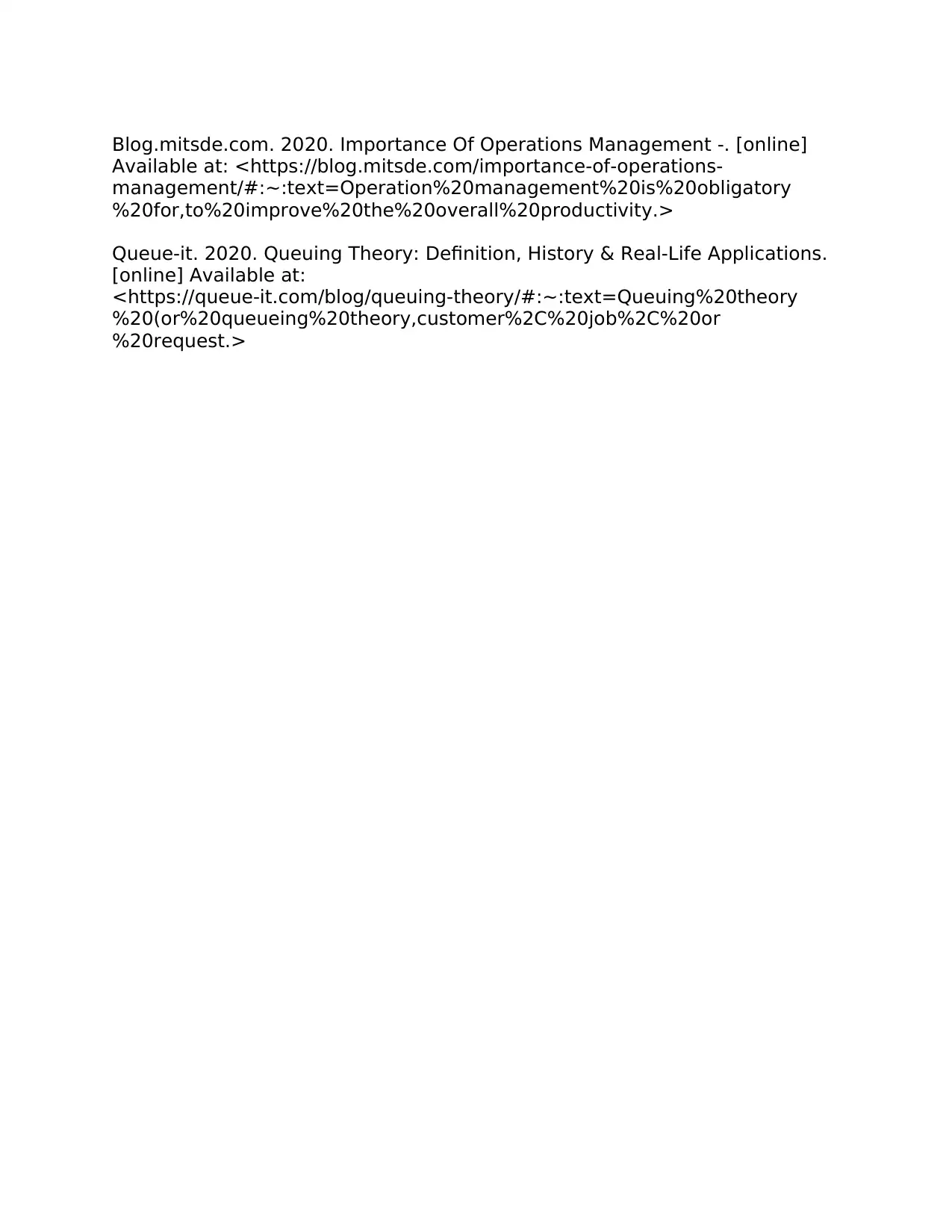
Blog.mitsde.com. 2020. Importance Of Operations Management -. [online]
Available at: <https://blog.mitsde.com/importance-of-operations-
management/#:~:text=Operation%20management%20is%20obligatory
%20for,to%20improve%20the%20overall%20productivity.>
Queue-it. 2020. Queuing Theory: Definition, History & Real-Life Applications.
[online] Available at:
<https://queue-it.com/blog/queuing-theory/#:~:text=Queuing%20theory
%20(or%20queueing%20theory,customer%2C%20job%2C%20or
%20request.>
Available at: <https://blog.mitsde.com/importance-of-operations-
management/#:~:text=Operation%20management%20is%20obligatory
%20for,to%20improve%20the%20overall%20productivity.>
Queue-it. 2020. Queuing Theory: Definition, History & Real-Life Applications.
[online] Available at:
<https://queue-it.com/blog/queuing-theory/#:~:text=Queuing%20theory
%20(or%20queueing%20theory,customer%2C%20job%2C%20or
%20request.>
1 out of 26
Related Documents
Your All-in-One AI-Powered Toolkit for Academic Success.
+13062052269
info@desklib.com
Available 24*7 on WhatsApp / Email
![[object Object]](/_next/static/media/star-bottom.7253800d.svg)
Unlock your academic potential
© 2024 | Zucol Services PVT LTD | All rights reserved.


